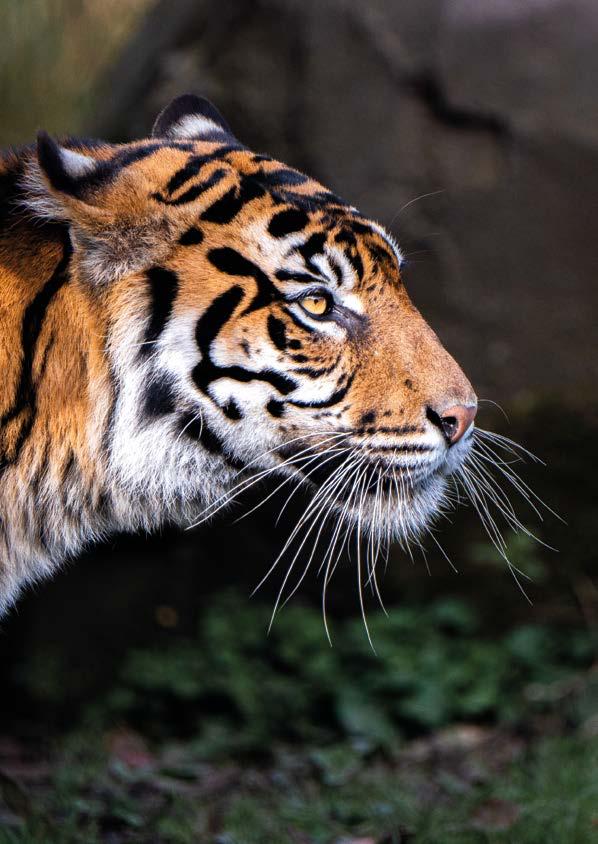
2023 chesterzoo.org The North of England Zoological Society Annual Report & Financial Statements for the year ended 31 December 2023 Focus on impact
The North of England Zoological Society (‘NEZS’) is a conservation and education charity that owns and runs Chester Zoo.
The Trustees of the North of England Zoological Society (‘Chester Zoo’ / ‘the Charity’ / ‘NEZS’) are pleased to present their annual report, together with the consolidated financial statements of the charity and its subsidiaries for the year ended 31 December 2023, which are also prepared to meet the requirements for a directors’ report and financial statements for Companies Act 2006 purposes.
The financial statements comply with the Charities Act 2011, the Companies Act 2006, the Charity’s Memorandum and Articles of Association, and Accounting and Reporting by Charities: Statement of Recommended Practice applicable to charities preparing their financial statements in accordance with the Financial Reporting Standard applicable in the UK and Republic of Ireland (FRS102).
Charitable objects
The Charity’s objects, as set out in its memorandum and articles of association, are:
(a) To promote the conservation of the physical and natural environment by promoting biodiversity
(b) To advance the education of the public on the conservation of the physical and natural world and the promotion of biodiversity; in particular by, but not limited to, the provision of public education, scientific study and the maintenance of endangered animals, plants and habitats in both protective and natural environments.
Registered Charity No. 306077
Registered Company No. 00287902

Read about our strategy to prevent extinction on page 14. The strategy brings together three key plans that will ensure that the zoo maximises its contribution to conservation and education, delivering tangible and lasting change.


14



2023 introduction 5 At a glance 6 2023 highlights 7 2023 animal births 9 STRATEGIC REPORT 11 Reasons to support us 12 A united strategy to prevent extinction 14 Financial review 2023 18 Risks and uncertainties 22 Sustainability at Chester Zoo 26 IMPACT REPORT ............................................................................ 29 Role of zoos 30 CASE STUDY – Impact on Species and habitat conservation – Reviving Bermuda’s endangered land snails 32 CASE STUDY – Impact on Education and training – Conservation education hub 34 CASE STUDY – Impact on Scientific research – Protecting the eastern black rhino 36 CASE STUDY – Impact on Public health and wellbeing – Nature recovery corridor (NRC) project 38 CASE STUDY – Impact on Conservation outreach – Mangabe landscape, Madagascar 40 CASE STUDY – Impact on Economy – Supporting the local area 42 CASE STUDY – Impact on Policy – Lobbying for sustainable trade policy 44 GOVERNANCE 47 Our leadership, governance and charitable purpose 48 Youth Board 54 S172 statement 56 Trustees’ responsibilities 60 INDEPENDENT AUDITOR'S REPORT AND FINANCIAL STATEMENTS ................................................................................. 63 Independent auditor’s report 64 FINANCIAL STATEMENTS 68 Consolidated financial statements 68 Notes to the consolidated financial statements 76 Sustainability reporting 90 Thank you 96 Contents 2023 saw a number of new additions to the Chester Zoo population. Read more about our animal births throughout the year on page 9. The Chester Zoo Youth Board is a voice for young people on matters that impact young people, particularly in relation to conservation decision making. Read more about this on page 54. 9 54 3 chesterzoo.org The TRUSTEES' REPORT can be found on pages 5 – 62 and 90 – 97

Welcome

Looking back, 2023 gave us the opportunity to set out our strategy from now until our centenary in 2031.
Parson’s chameleon (Calumma parsonii parsonii)
4 | Annual Report 2023
2023 introduction
 Christon Chief Executive Officer
Christon Chief Executive Officer
 Ardron Chair of Trustees
Ardron Chair of Trustees
We are pleased to introduce our 2023 annual report.
This year, both myself and Malcolm would like to introduce our 2023 annual report and highlight just some of our impact both at our home in Chester and around the world. Within the report, you’ll find a range of case studies and reports on our conservation impact, which we hope you find interesting.
Looking back, 2023 gave us the opportunity to set out our strategy from now until our centenary in 2031. The six ambitious and exciting targets in our Conservation Plan are now aligned with our plans to develop our Chester site. Both plans are supported by an achievable, robust and resourced organisational plan. Our trustees and leadership team are now focused on delivering against these three plans through to our centenary.
We reported on several milestones in our work in conservation during the year, such as our work to rescue the endangered stonefly here in Cheshire and breeding breakthroughs surrounding key species such as the Mitchell’s lorikeet and our Komodo dragons.
We also began the development of our new Heart of Africa zone and our upcoming hotel – both of which will open in 2025. In addition, we made great progress on our new snow leopard habitat, which opened in March 2024 and will see the zoo contribute to protecting these magnificent animals as part of an international breeding programme.
We’ve also made great strides in expanding our science facilities here at Chester as part of a partnership with URENCO. The new centre will help us provide leading scientific services across European conservation projects, provide more training, house our new biobank and allow our leading scientists to continue to develop breakthroughs in conservation science.
Our impact in public affairs continued to drive the conservation agenda in parliament, with cross-party visits from a number of sector related ministers and the Shadow Tourism Minister, as well as a strong involvement at the Conservative Party and Labour Party conferences.
Delivery of our impressive education programme was supported by the opening of a new Conservation Education
Hub in September and becoming Ofsted accredited at the end of the year. Last year also saw the launch of the first PGCert in Conservation and Sustainability Education alongside our partner, the University of Chester.
Driving our commercial income has never been more important, as we scale up our plans to deliver impact in conservation. During 2023, our teams delivered campaigns across British wildlife, Easter, Luminous (our new immersive digital experience), summer, Halloween, weddings, corporate hire, education, membership and adoptions. The campaign calendar culminated in welcoming over 150,000 visitors to Lanterns and Light at the end of the year, a new partnership with Sony designed to drive forward our winter offering for visitors.
We also had significant impact outside the zoo gates in the media. We worked to drive coverage of the zoo’s conservation work, reaching 77 million people via social media and generating over 15,000 pieces of press coverage. We secured a range of TV programmes, including a BBC series hosted by Steve Backshall and an international CNN documentary following our work to reintroduce endangered species to the wild.
The governance structure within Chester Zoo was strengthened with the appointment of Yvonne Emmett Cannell, Simon Cripps, Martin Harper, Angie Robinson and Neill Skinner as Trustees in June. Our thanks to Will Beale, Edwin Christmas and David Chinn, who retired as Trustees during the year. We also had the support of our team of employees and volunteers, who are integral to our success.
In all, we recovered to a pre-pandemic number of visitors, with nearly 2 million visits during the year and peaked at close to 150,000 members.
We are ready for 2024, and the future of our zoo is robust and resilient. We aim to continue to focus on ensuring our sustainability as we guide our zoo through what are uncertain times both nationally and internationally.
We hope you enjoy reading our review of 2023 and look forward to seeing you at Chester Zoo in 2024.
 Jamie Christon Chief Executive Officer
Jamie Christon Chief Executive Officer
Date: 3 May 2024
Malcolm Ardron Chair of Trustees
Malcolm
Jamie
5 chesterzoo.org
Visitors & donors
Conservation
We had
1,971,178 £2.0m
We received visitors to the zoo in donations to support our vital conservation work
Read more in our financial review on page 18
We spent
£21.3m 62,548
We worked with on habitats, species and populations animals of 580 different species in the zoo
Education
Employees & volunteers
We spent
We had on conservation education activities education visits £4.1m
Read more in our Case study – Impact on species and habitat conservation on page 32 Read more in our Case study – Impact on education and training on page 34
122,983
Zoo estate
When asked,
We had of our employees said they were proud to work at Chester Zoo hours donated by volunteers 86%
26,824 Read more in our public benefit statement on page 57
We invested We generated in capital projects of renewable energy on site from solar PV £21.2m
209,000kWh
At a glance
6 | Annual Report 2023
Read more about sustainability at Chester Zoo on pages 26–27
2023 highlights
Planet Shark opens

The zoo brought the world’s most innovative ‘out of water’ shark experience to the UK for the first time.
Planet Shark – a ground-breaking immersive exhibition – highlighted the wonder of sharks and the wide-ranging threats they face, including ocean plastics and illegal shark fin trade, leaving people with a new level of respect for the ocean’s oldest and most effective predators.

Stoneflies rescue mission
Zoo staff became the first in Europe to successfully breed a rare stonefly, which was rediscovered 22 years after being declared extinct.
The zoo team, renowned for its work to bring species back from the brink, were called in to start an emergency breeding effort for the critically endangered scarce yellow sally stonefly – part of a rescue mission to save the
species from extinction following its rediscovery in the River Dee, North Wales.
The success added valuable scientific insight into the species and boosted long-term plans, involving multiple project partners, to safeguard its future in the UK.
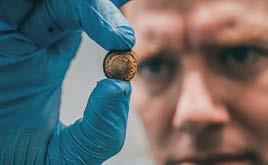
Zoo joins Cheshire Science Corridor
The zoo formed an exciting new partnership with businesses and partners in the Cheshire Science Corridor to work on cutting-edge and world-leading research.
The corridor links together national and international research facilities and sciencebased businesses, providing opportunities for collaboration and innovation.
It’s believed the zoo is the first in the UK to become part of any major science and technology cluster, aiming to drive work that will change the world for the better.

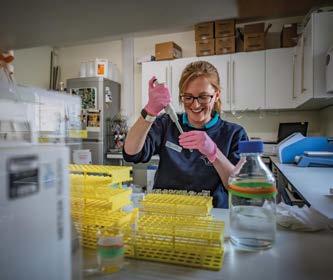
7 chesterzoo.org

The Square launches
A luxury new wedding and events venue, The Square, opened following a three-year project to restore a Grade II listed stable block.
The historic building, which has stood at the heart of the zoo since it opened in 1931, was once home to some of the zoo’s first animals, including lions, bears and chimpanzees.


New learning centre opens
A new state-of-the-art education centre to inspire and empower future conservationists opened at the zoo.
The new Conservation Education Hub, featuring three large classrooms and a recording studio, will host more than 50,000 children, young people, students and teachers every year.
Conservation education experts at the zoo say the new facility is a key milestone in its ambitions to support the next generation to take positive action for the planet.



Inka the jaguar
A rare black jaguar, named Inka, arrived at the zoo as part of a special programme that’s caring for the species across Europe.
The two-year-old female jaguar moved from The Big Cat Sanctuary in Kent, having been carefully selected as a fitting companion for resident male jaguar, Napo.
Carnivore experts at the zoo hope Inka’s arrival will help to increase the spotlight on the remarkable species.

8 | Annual Report 2023
2023 animal births
In 2023, we welcomed a number of new additions to the zoo

Tree kangaroo joey
An endangered Goodfellow’s tree kangaroo – the first ever born at the zoo – began to emerge from mum Kitawa’s pouch.
The birth was a boost to the international conservation breeding programme working to protect the highly threatened animals – with only one other zoo in the UK currently caring for the species.
In a bid to discover more about these little-understood kangaroos, our zoo teams documented the growth of the joey using a special endoscope camera carefully placed into Kitawa’s pouch.
Experts say the data collected could help to provide new insights on tree kangaroos, potentially aiding conservation action plans for the species.

Tiger cubs
Two critically endangered Sumatran tiger cubs were born at the zoo, marking a significant step forward for the global conservation breeding programme working to protect the species.
The female cubs, born to parents Kirana and Dash, were named Alif and Raya by the zoo’s team of carnivore experts.
Sumatran tigers are found only in patches of forest on the Indonesian island of Sumatra, where it’s estimated as few as 350 may remain.
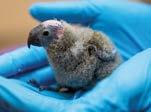
Mitchell’s lorikeets
Two extremely rare Mitchell’s lorikeets hatched at the zoo in what was labelled a pivotal moment for the species.
The precious parrots are one of the world’s rarest birds and face extinction in the wild. They were once found on the Indonesian islands of Bali and Lombok, but latest searches have found only a handful remaining. Extensive hunting and trapping for the illegal wildlife trade has driven the drastic decline in numbers.
The chicks join an endangered species breeding programme, which was set up to form a vital safety-net population in conservation zoos across Europe.
Primate experts at the zoo became the first in Europe to breed the critically endangered Coquerel’s sifaka lemur.
Chester Zoo is currently the only zoo in the UK – and one of just three in Europe – to care for this charismatic species. New parents Beatrice and Elliot were transferred from the Duke Lemur Center in the USA in 2021 to begin a new conservation breeding programme aimed at safeguarding the primates from extinction.
Komodo dragons
The zoo celebrated the arrival of two baby Komodo dragons – the world’s largest living lizard species.
It was the first time zoo experts had successfully bred hatchlings from a pair of mating dragons, with the eggs having been carefully incubated for more than six months.

The duo join a vitally important international conservation breeding programme working to safeguard dwindling dragon numbers and ensure a healthy population in zoos. In tandem, zoo conservationists, together with partners, are striving to protect Komodo dragons on the island of Flores, working with communities on the island to find ways to help humans and dragons to coexist.
 Sifaka
Sifaka
9 chesterzoo.org


Did you know?


Did you know that our new botanical collection of spirits, including our spiced rum, sloe gin, vodka and range of traditional gins, all contain ingredients sourced from our award-winning gardens here at the zoo?
The collection can be bought on site at Chester Zoo and through our website.
10 | Annual Report 2023 Strategic Report
Strategic Report Reasons to support us 12 A united strategy to prevent extinction 14 Financial review 2023 18 Risks and uncertainties 22 Sustainability at Chester Zoo 26 11 chesterzoo.org

Reasons to 6 support us

Become a supporter today
Anything you can give will really make a difference in supporting our conservation work. There are so many ways to support. Find out more using the QR code below.
Our conservation zoo is vital in preventing extinction
1
As a conservation powerhouse, we’re working around the world to ensure species not only survive but thrive. Research shows that more than half of the million species under threat of extinction need active conservation management in the field, and 16% of threatened species globally require ex-situ conservation in zoos like ours if they are to have any chance of survival at all.



12 | Annual Report 2023 Strategic Report
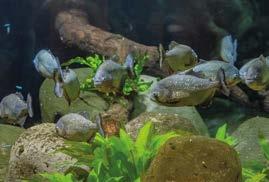
We drive innovation in zoo science
We partner with NGOs and universities to drive critical discoveries that help prevent extinction. From our expertise in social sciences to our state-of-the-art endocrinology lab, our experts are at the cutting edge of science.

From the 123,000 school children that visited the zoo in 2023 to providing teacher training, professional development and our work with fellows and scholars, educating and inspiring the conservationists of the future is one of our key focuses.
We protect and restore biodiversity across the world
We work to ensure conservation is top of government agendas We educate the conservationists of the future 2 5 4 3 6
We empower the public to protect biodiversity and the environment
We work to inspire and empower the public to live more sustainably and to take action to help protect the environment. We connect with people during their zoo visits and encourage them to take action for nature every day.
We work with 62 partners in 6 key regions across the world to protect key species and landscapes that are under threat. We take a 360 approach to conservation, working with species at our hub in Chester as well as in the field, protecting landscapes and working with local governments, communities and NGOs to deliver lasting impact.

We partner with both national and international networks to drive the conservation conversation and agenda. We help ensure the protection of species is prioritised by influencing both government policy and corporate practice.


13 chesterzoo.org
A united strategy to prevent extinction
Chester Zoo has an ambitious strategy that takes the charity to its centenary in 2031. This strategy looks to ensure the zoo maximises its contribution to conservation and education, delivering tangible and lasting change across six key conservation targets.
The delivery of the zoo’s conservation work is intrinsically linked with the strategic development of our zoo site and the development of our organisation more broadly.
The organisational plan drives vital and significant growth in income to enable the delivery of our conservation efforts, as well as driving stable and sustainable growth to enable the continued development of our Chester site.
The Strategic Development Plan (SDP) for the zoo site is also symbiotic with both the delivery of the organisational plan and the Conservation Plan (CP). The continued development of animal habitats and the customer experience on-site is key to driving income growth through visitation. The development of our facilities to enable cutting-edge provision of science, education and work with endangered species at the Chester site is also vital to the delivery of the CP targets.
Species & habitats Science Conservation education & engagement Legislation & public affairs
plan
growth
Brand & marketing People & culture
Strategic Development Plan (SDP) Existing zoo estate New strategic developments Sustainability Organisational plan The Conservation
PREVENTING EXTINCTION 14 | Annual Report 2023 Strategic Report
The Conservation Plan (CP)
Organisational
Commercial
Fundraising
The
Plan (CP) The Strategic Development Plan (SDP)
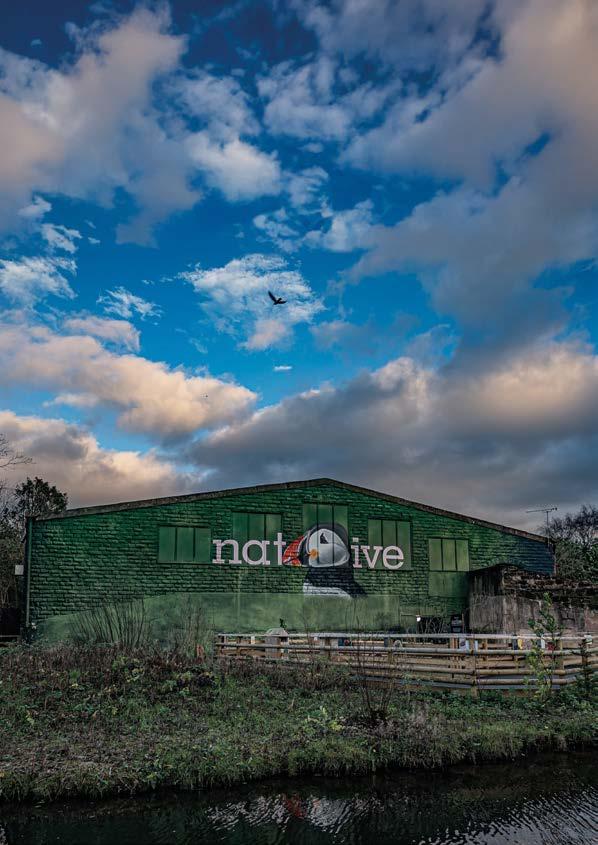
Organisational plan
In order to achieve the mission and deliver the Strategic Development Plan (SDP) and Conservation Plan (CP), Chester Zoo needs to remain financially successful, as well as grow and diversify its income streams. This plan maps the key elements of activity to achieve this:
• The zoo’s commercial strategy will deliver both the continued growth of visitor income as well as the introduction and growth of new income streams in order to maximise overall growth and manage risk through diversification.
• The fundraising strategy will drive increased visibility of the zoo as a charity, as well as increase the income generated through public fundraising, partnerships, trusts, foundations and philanthropy.
• The zoo’s brand strategy will reposition the zoo as a leading international conservation charity, in order to enable growth across all areas of the organisation. The communications strategy will enable the zoo to reach and attract a wider set of audiences, embedding the new brand position and enabling growth across existing and new income streams.
• The people strategy will develop the zoo with a ‘one team, one mission’ approach, invest in leadership skills for existing and future leaders, improve employee engagement and satisfaction, and continue to focus on equality, diversity and inclusion. It will also enable the growth of the workforce across functions in order to enable the delivery of all three plans.
• The sustainability strategy sets out our approach to sustainability across the organisation and four key targets on carbon net zero, zero waste, deforestation-free commodities and UK biodiversity. It ensures the zoo and its organisational plans are building towards a sustainable future, aligned to global standards and legislation.
• The public affairs strategy will focus on driving positive political outcomes for our zoo and the wider sector, as well as lobbying for nature across the political spectrum.
15 chesterzoo.org


The Strategic Development Plan (SDP)
The SDP sets out a plan to transform the zoo through the development of habitat-themed environmental zones, aligned with and supporting our CP, while ensuring the zoo is in the best position to attract visitors to the site. The plan focuses on two key strands of activity:
• New strategic developments to the zoo across key zonal areas (including Heart of Africa, which will open in 2025), key facilities to enable conservation (including the new science centre) and key areas of new income growth (including our first overnight stays development). From


late 2028 onwards, the third phase of our plan will begin, with plans to replace existing habitats to the north of the zoo around a zone currently named ‘African Forests’.
• The management plan for the existing zoo estate continues to support our excellent conservation work, animal welfare standards and visitor experience. It details continued investment in major repairs across the site, the upgrading of infrastructure with a focus on renewable energy and climate resilience and the upgrading of the working environment for our employees.

Strategic Report 16 | Annual Report 2023
The Conservation Plan (CP)
The CP focuses on a holistic approach to deliver lasting impact, focusing on four Ps: the protection of animal and plant populations, the places that need to be protected to allow species to thrive, the people that impact these environments and the policy areas which affect conservation outcomes at a wider level. The zoo has six key targets that it’s pledged to meet by 2031, which are enabled by the following plans:
• Our species plan for animals and plants is aligned with the CP and sets out a targeted approach to species recovery in a number of key regions across the globe. This plan will develop over the period to 2031 as biodiversity challenges evolve.
• The zoo’s scientific plan also underpins the CP, building on our reputation for groundbreaking conservation science and establishing the zoo as an international centre of excellence in zoo conservation science. Working with our own staff and through collaborative partnerships, we’ll also seek to scale up our impact and become a ‘conservation multiplier’ through training others.
• Our conservation education and engagement team will expand its programmes of work over the period of the CP, providing resources for schools to embed conservation in the curriculum, increasing engagements with zoo visitors, improving facilities for learning at the zoo, developing a comprehensive youth programme to increase opportunities for young people to actively participate in conservation and increasing access to conservation through reaching out to more diverse and underserved audiences.
• Our public affairs plan will focus on scaling up our influence and reach via engagement with a wider set of stakeholders and a broader range of policy agendas to support the delivery of the CP. Working with other leading conservation zoos, bodies such as BIAZA and EAZA and with the wider conservation sector, we’ll respond to and seek to influence emerging political and regulatory challenges impacting Chester Zoo and the conservation and education sector.

Scan to view the Conservation Plan Find out more! F species through conservation breeding and propagation 150 options for future conservation for an additional 250,000ha landscapes for wildlife, totalling major policy areas for wildlife 5 conservationists 5,000 people to live more sustainably 10 million 200 threatened populations of species in the wild declines of POPULATIONS PLACES PEOPLE POLICY PREVENTING EXTINCTION 17 chesterzoo.org
Financial review 2023

With diversification in income streams, increases in spend on our charitable activities and significant capital investment on the Strategic Development Plan, 2023 was another year of growth.
The year presented particular challenges, with consumer confidence impacting spend on leisure activities and continued inflationary pressure on costs. But despite that, we were pleased to see growth in our income, visitor numbers and memberships.
As we enter 2024, capital investment has continued at pace, and we’re pleased to see some signs of consumer confidence returning. However, inflationary pressures on costs have not subsided – the most significant being the increase in the National Living Wage – and so we continue to push for growth in our income to provide the resources needed to deliver our mission of preventing extinction.
Liz Carnie, Corporate Director
Key highlights
Total income 2023
£57.4m
An increase of £6.7m from £50.7m in 2022
Income from trading activities
£16.4m
An increase of £2.4m from £14.0m in 2022
Expenditure on charitable activities
Income from memberships
An increase of £1.5m on 2022, with 8,254 more members
Capital investment in the zoo
£21.2m
Compared to £6.4m in 2022
Employment costs of
£23.8m
£26.2m £12.3m
An increase of £1.5m from £24.7m in 2022
In summary
An increase of £2.7m on 2022, with 53 more full-time equivalent roles
2023 saw growth in visitors to the zoo, driven by an increase in memberships and events such as Lanterns and Light. However, the costs of operating the zoo and delivering our charitable activities increased further.
Total income for 2023 was £57.4m, an increase of £6.7m from 2022 (2022: £50.7m). The growth came from zoo memberships and adoptions, fundraising, events and experiences, together with the successful launch of The Square, a dedicated venue for weddings and events.
Expenditure for 2023 was £57.7m (2022: £49.2m), an increase of £8.5m. While some increase in costs was directly linked to the growth in income, increasing inflation also impacted our operating costs, which included some one-off set-up costs for new ventures, meaning that our operating costs grew by an amount greater than our income growth.
At the end of the year, we reported a net decrease in funds of £0.3m (2022 net increase of £1.4m), which included a £0.5m expense relating to the fair value of interest rate hedges which will reverse in future years.
During the year, we secured a borrowing facility to deliver the Strategic Development Plan, including the Heart of Africa and the overnight stays development projects. After spending £21.2m on capital projects and maintaining a free cash reserve of £4.4m, we ended the year with net borrowings of £6.9m (2022: net cash of £5.4m).
18 | Annual Report 2023 Strategic Report
Incoming resources
Most of Chester Zoo’s income comes from the zoo’s visitors and members, in the form of admissions income, membership fees and spend on site. This is supplemented by income from donations, grants and legacies.
Visitor numbers for 2023 were 1,971,178 – an increase of 7% on 2022 (2022: 1,848,634). While an improvement on the previous year, our standard visitors, who buy a single day admission ticket, fell back slightly, with poor weather and increased competition impacting key holiday periods. But this was offset by increased visits by our members and by attendance at events such as Lanterns and Light.
School visits remained at a level consistent with the prior year, with 69,088 visits made for free across our winter free tickets scheme and outreach programmes.
Income from visitor admissions was £20.0m (2022: £19.4m).
Our membership numbers grew again and we ended the year with 146,232 members (2022: 137,978). Consistently with 2022, 33% of visits were made by members. Income from memberships, including related Gift Aid, was £12.3m (2022: £10.8m).
In the summer, we once again opened the zoo to visitors during the evening for our Into The Night events, and in November and December, our enhanced Lanterns and Light event received fantastic feedback. Over 167,000 visitors came to these events in 2023, compared to 134,000 in 2022. Income from events and experiences in the zoo was £2.7m (2022: £2.0m).
In 2023, income from grants increased to £0.8m (2022: £0.5m), which included funds from the Green Recovery Challenge Fund for our Nature Recovery Corridor project.
Total income from these charitable activities was £36.4m (2022: £33m).
As a registered charity, Chester Zoo generates voluntary income from visitor donations (and Gift Aid thereon), animal adoptions, legacies, grants and other donations. Donations from zoo visitors and related Gift Aid increased to £2.0m (2022: £1.7m), as we saw a welcome uplift in donations received online.
Income from animal adoptions, legacies and other donations increased to £2.3m (2022: £1.9m), with the receipt of several generous legacy gifts for which we are very grateful.
The Society’s trading subsidiary, Chester Zoo Enterprises Limited, which provides retail and food & beverage offerings across the Zoo site, had a turnover of £16.4m in 2023 (2022: £14.0m), with a doubling of income from venue hire following the launch of The Square.
Project grants, contributions and other charitable income
Zoo events and experiences
Donations, grants and legacies
Membership income and Gift Aid
Trading activities
Visitor admission income
Resources expended
In 2023, Chester Zoo’s expenditure was £57.7m (2022: £49.2m), excluding capital investment of £21.2m.
With growth in activities combined with increasing inflation, expenditure on our charitable activities increased to £26.2m (2022: £24.7m).
Expenditure on habitats, species and populations
Expenditure on conservation education, engagement and capacity building
Expenditure on conservation advocacy
In 2023, we spent £30.4m raising funds (2022: £24.6m), with £2.5m spent on generating membership income, donations and legacies (2022: £2.5m). The costs of visitor admission and experience at the zoo rose to £12.4m (2022: £8.8m).
0 10 20 30 40 50 60 2023 2022 2021 2020
0 5 10 15 20 25 30 2023 2022 2021 2020
Income 2020 – 2023 in £m
19 chesterzoo.org
Expenditure on charitable activities 2020 – 2023 in £m
With its significantly increased income following the launch of The Square, Chester Zoo Enterprises had trading costs of £15.5m (2022: £13.3m), excluding rent paid to the Society of £0.7m (2022: £0.7m). Chester Zoo Enterprises made an operating surplus of £0.2m in 2023 (2022: £21,000).

Costs of generating memberships, donations and legacies
Cost of visitor admission and experience
By far the biggest element of operating expenditure (2023: £23.8m, 2022: £21.1m) continues to be the payroll cost for our employees, with investment having been made in several teams in support of the delivery of our strategy. Our average full-time equivalent (FTE) headcount for 2023 was 661, compared to 608 in 2022.
In 2023, with work underway on Heart of Africa and the overnight stays development, drawings on the banking facility increased and interest of £0.6m was incurred. The charity took out both an interest rate collar and an interest rate swap to provide some protection against interest rate fluctuations in 2024/25. Accounting standards require that these instruments are measured at fair value at the balance sheet date and the movement in their value is reflected in the financial statements. This resulted in a £0.5m expense in 2023, which will reverse in 2024/25.

Capital expenditure
In 2023, work on the zoo’s Strategic Development Plan continued and £21.2m was invested in the zoo estate (2022: £6.4m), which included investment of £1.0m for the purchase of a 70-acre farm adjoining the zoo estate. Capital projects undertaken included completion of The Square and our new Conservation Education Hub, both of which opened during the year. Development commenced on a snow leopard habitat, which opened in spring 2024, and the start of work on Heart of Africa and the overnight stays development, which will open in 2025. Alongside these visitor-facing projects, there was significant investment in electrical infrastructure, in support of the aspiration to move away from fossil fuel use on site, and an extension to our science laboratories, funded by one of our corporate partners.
0 5 10 15 20 25 30 35 2023 2022 2021 2020
0 5 10 15 20 25 2014 2015 2016 2017 2018 2019 2020 2021 2022 2023 10-year investment
in £m 2014/15 expenditure was on the Islands development. • 2019/20 expenditure included reinstatement of the Monsoon Forecast after a fire. Strategic Report 20 | Annual Report 2023
Trading costs Expenditure on raising funds 2020 – 2023 in £m
in the zoo
Borrowings, investments and reserves
It is the general policy of the Charity to apply towards its charitable objectives as much funding as it reasonably can and to avoid accumulating excessive cash reserves. Where considered appropriate, borrowings are undertaken to fund elements of significant capital projects and the charity is currently borrowing to fund the Heart of Africa and the overnight stays developments.
In setting its cash reserves policy, Chester Zoo takes account of its continuing financial commitments in terms of employees and overheads, including the costs of caring for the zoo’s animal and plants, alongside funding of charitable activities that take place outside the zoo, together with any contractual commitments for capital projects. The charity also considers the risk that its income for any particular year may be impacted by a number of factors outside of management’s control, such incidents that could close all or part of the zoo to visitors for prolonged periods, competition from other visitor attractions, social trends and recession.
Throughout 2023, the Society maintained minimum available cash reserves of £4.4m, which were supplemented by a minimum £1.9m of undrawn committed borrowing facilities. Such reserves being sufficient for the zoo to operate without significant curtailment of its activities for a period of up to three months.
At the end of 2023, the Society had borrowed £12.4m and had £5.5m of cash reserves, including £0.3m of cash reserves held in escrow for the defined benefit pension scheme (2022: £0.8m borrowings and £6.2m of cash reserves). At 31 December 2023, the Society’s borrowing facility, in place to fund the Strategic Development Plan, was £45.0m. At 31 December 2023, the Society had access to £32.6m of undrawn borrowings and £5.2m of cash reserves (excluding the escrow account).
Pensions
The Society’s defined benefit pension scheme was closed to future accrual in 2012, and in 2021, agreement was reached to enter into a buy-in policy with Aviva, which fully matches the scheme liabilities, and a final contribution of £2.1m was made in 2021. The formal winding up of the scheme is underway and is expected to be completed in 2024. A balance of £0.3m remains in the escrow account, which will be used to fund the wind-up of the scheme and any excess funds are then expected to be released back to the Society.
The Society operates a defined contribution scheme that is open to all employees. For permanent employees who contribute 3% or more, the Society makes a contribution that is 2% more than the employee contribution up to a maximum of 9%. Qualifying seasonal employees are enrolled into
the NEST pension scheme, with contributions in line with government rates.
Restricted and designated funds
Restricted income funds derive from donations, grants and legacies received and are put towards a variety of specific capital projects and conservation activities. Unrestricted income funds may be designated or freely available for the Society’s general charitable purposes.
After setting aside restricted income funds, the Society keeps a minimum cash deposit of £4.4m set aside as a free reserve. The balance of available funds at the balance sheet date are designated as follows:
• To the defined benefit pension scheme, with funds held in escrow to cover the wind-up of the scheme in 2024.
• To funds that could only be realised by disposing of fixed assets held for charitable use, up to a maximum of the net book value of those fixed assets at the balance sheet date.
The Trustees do not consider it necessary to retain income in respect of the Society’s designated fund activities. While these funds have been earmarked by the Trustees for particular purposes or uses, they are not committed or restricted legally.
At 31 December 2023, the Group had total funds employed of £63.6m (2022: £63.9m) of which £0.9m (2022: £0.9m) were restricted, £4.4m were free (2022: £4.4m) and the balance of £58.3m (2022: £58.6m) were designated.
Going concern
The Trustees of the Charity and group have adopted the going concern basis of preparation for the financial statements. The Trustees have arrived at this opinion having reviewed budgets and forecasts, working capital requirements and borrowing facilities for the period through to 31 May 2025, considering reasonable downside scenarios alongside commitments for capital developments during a period of significant borrowings ahead of the completion of the Heart of Africa and overnight stays development in spring 2024. They are satisfied that the charitable parent company and the group are able to adequately fund operations and commitments for the foreseeable future. Further detail can be found on page 71.
21 chesterzoo.org
Risks and uncertainties
Risk management
The Trustees of Chester Zoo have a risk management strategy that sets out responsibilities for risk management across the organisation, the risk appetite, a process for reporting, review and escalation in relation to identified risks and links to the internal control environment and external legal frameworks.
Through maintaining a risk register, Trustees actively review the major risks that Chester Zoo faces on a regular basis against the relevant mitigating internal controls and actions being taken to manage risk. By ensuring cash reserves are kept at agreed levels, and by putting in place appropriate insurances, Trustees are satisfied that there will be sufficient resources in the event of most adverse conditions.
Risk appetite
Chester Zoo’s risk appetite sets out the types or levels of risks that the Charity is prepared to take in pursuit of its mission. The following principles outline the appetite for risk:
• All activities must be consistent with Chester Zoo’s strategy and not in contravention of the Charity’s policies and procedures. Chester Zoo will always seek to comply with statutory and regulatory requirements. It’s acknowledged that to achieve the mission of preventing extinction, it may be necessary to take controlled risks within the activities and that may include actions taken in managing the animals and plants within our care. Chester Zoo is particularly cautious about risks that relate to health & safety and animal welfare.
• Chester Zoo mitigates against activities that carry the risk of substantial adverse impact on the Charity. Chester Zoo does this by recording and assessing risks and the relevant mitigating controls and subsequently by monitoring the effectiveness of those controls in the risk register and through, in certain circumstances, external assurance. The risk register is reviewed at least three times a year by the Audit & Risk Management Committee and at least annually at a full Trustee meeting, with significant changes reported to the Trustees when they arise.
• Chester Zoo has an appetite to take on new projects and explore opportunities as part of the organisational strategy. When significant new projects are undertaken, there is an analysis of both benefits and risks to ensure that the outcomes are consistent with and support our strategy, that the financial consequences are supported by available reserves and that the reputation of the Charity is not put at risk.
There are over 20 risks identified within the risk register. The latest review of the risk register identified the risks set out in the following tables as likely to have the most significant impact on Chester Zoo.
Risk
Strategic Development Plan delivery
Delivery of the Strategic Development Plan is impacted by increases in cost and/or a lack of available resources, including funding.
Potential impact High
Delivery of strategic development of the zoo is key to ensuring future income from visitors as well as providing the right environment for our plants and animals.
Rising construction costs and shortage of materials may delay the delivery of projects.
Ongoing development of the site causes disruption to the visit and may negatively impact the visitor experience.
With projects funded through a combination of cash generated from operating activities and external borrowings, a significant downturn in trading could delay delivery of projects.
How do we manage the risk?
The Strategic Development Plan sets out a long-term vision for controlled development of the site.
Budgets for all strategic development projects are developed with both in-house resources and external specialists.
All major projects are put out to tender with a minimum of three tender returns required for each project to ensure value for money is achieved.
Regular review of project status, cost estimates and contingencies are overseen by steering groups and the Strategic Development Committee.
In years with significant construction work, ongoing investment is made in programming to enhance the visitor experience.
Regular review is undertaken of trading and borrowing forecasts before contractual commitments are made, with ongoing communication with the charity’s bankers Santander.
More detail on how the Trustees have considered the level of planned capital expenditure against trading forecasts and borrowing facilities can be found in the going concern section on page 71.
Probability (after management) Possible
Change in the perceived risk in the last 12 months
Risk has increased due to the level of construction activity on site for Heart of Africa and the overnight stays development alongside continued cost inflation.
Strategic Report 22 | Annual Report 2023
Risk
Major incident
That there is a major incident which threatens human or animal safety and/or risks Chester Zoo’s assets and reputation.
An example of such could be a dangerous animal escape, an act of terrorism, an outbreak of disease or a cybersecurity attack.
Potential impact
Very high
Such an incident could cause significant financial loss and significantly risk our ability to operate in the future.
Chester Zoo relies on visitors, members and donors for the majority of its income and therefore keeping the zoo open and welcoming visitors is key to financial sustainability.
How do we manage the risk?
Chester Zoo has in place documented risk assessments, emergency procedures and business recovery plans. Regular practice drills are undertaken, consulting with emergency services.
A number of independent audits take place each year to review and check compliance with internal policies, procedures and controls.
A schedule of insurances is renewed annually by the Audit & Risk Management Committee. A cash reserve is held to mitigate any period when the zoo is closed. Probability
Risk
Recruiting, developing and looking after the health and wellbeing of our employees
Failing to be an attractive employer, bringing relevant skills in to the organisation, or to look after our employees through providing a safe working environment with opportunities to train and develop.
Potential impact Medium
People are key to the delivery of our mission, and if we are unable to recruit and retain an appropriately skilled and engaged team, then delivery of our strategy and mission will be compromised.
How do we manage the risk?
All of our employees have a clearly defined job role, and we have a clear and transparent job grading process that is independently reviewed. All staff undertake a detailed induction and have access to both mandatory and optional training each year.
All employees take part in an annual performance and development review, which helps determine training needs. In 2023, we invested in accredited leadership training for 19 senior managers. 40 managers completed our bespoke management training programme.
32 managers took part in Mental Health in the Workplace training.
Our Staff Association, comprising representatives from across the organisation, meet regularly with the executive directors to discuss matters impacting staff. An annual staff survey provides insight into engagement levels and what is important to our people.
We have an internal occupational health resource and a health & safety team to support staff, and systems are in place for staff to report issues and concerns.
All staff receive weekly bulletins and regular updates from individual directors and are able to attend quarterly briefings where they can ask questions of the director team.
In 2023, we continued to run activities to support staff under the four pillars of mental, physical, social and financial wellbeing
Probability (after management) Possible
Change in the perceived risk in the last 12 months
Risk has increased in the period due to the cost-of-living crisis, world events and a reduction in the number of candidates for vacancies.
management) Unlikely
(after
Change in the perceived risk in the last 12 months No change in the period.
23 chesterzoo.org
Increase in cost and shortage of availability of utilities and other commodities
Significant inflation, particularly in respect of wages, utilities and construction materials, is driving operating costs upwards.
Climate – an increasing risk
Increasing costs will impact Chester Zoo’s financial stability and ability to deliver its charitable activities and invest for the future through the Strategic Development Plan.
How do we manage the risk?
Annual operating budgets and project budgets include allowances for anticipated cost increases and include contingencies.
A longer-term business plan sets targets for growth and diversification of income streams to support activities.
The Strategic Development Plan and Conservation Plan span a 10-year period and allow for some change in the pace of delivery if resources are constrained.
Commitments made to reduce our carbon footprint and waste generation are focused on reducing usage by improving existing operations and infrastructure and having sustainability at the heart of future plans and developments.
Probability (after management)
Change in the perceived risk in the last 12 months
Risk has reduced in the period due to reduction in inflation levels.
Climate change presents significant transitional and physical risks and opportunities to Chester Zoo that we are beginning to prepare for.
Climate change is one of the key drivers of global biodiversity loss, so Chester Zoo's work to prevent extinction is directly addressing the impact of climate change and there'll be more need for our work in future as the impacts of climate change increase.
Climate change will directly impact our site and activities. We're already seeing the impact of extreme weather, like an increase in storms, extreme rainfall, drought and heatwaves, which can cause disruption to zoo operations, damage our assets, result in the temporary closure of the zoo to visitors and pose a risk to the habitats, animals and plants in our care.
There are also transitional risks from increasing regulation, rising costs of materials and utilities and changing consumer preferences that could result in impacts to our business.
Chester Zoo's leadership have held a workshop with an external facilitator to consider the risks and opportunities around climate change and how these could be addressed.
Issues discussed in the workshop included how we adapt our site and developments to address climate risk, e.g. through the Strategic Development Plan. This could include more shelter from extreme rainfall and heat, measures to better manage surface water on site and designing our infrastructure to withstand future climate conditions. Risk
impact Medium
Potential
Possible
Strategic Report 24 | Annual Report 2023

25 chesterzoo.org
Sustainability at Chester Zoo
To achieve our mission of preventing extinction, itʼs essential that we address the global threat to biodiversity presented by climate change, waste pollution and the over-exploitation of natural resources. Thatʼs why weʼre taking action on sustainability at Chester Zoo.
In 2023, we continued to strengthen our efforts around sustainability, including:
• Publishing our new Sustainability Policy, which sets out our commitments for sustainability
• Introducing a fourth sustainability target to achieve net gain for UK biodiversity on site, with at least 30% of zooowned land being managed for UK biodiversity by 2030
• Installing 42.5kWp of solar PV on two buildings and four air source heat pump systems (153.5kW total capacity)
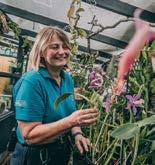
Our sustainability targets
• Improving our operational waste recycling rates, with 44% of operational waste now being reused or recycled
• Collaborating with our supply chain on sustainable solutions, including deforestation-free products
• Continuing our restoration and management of UK biodiversity areas across site
• Preparing for legislative, policy and reporting requirements relating to sustainability
• Using our powerful voice to influence change in policy and industry around sustainability
Find out more about sustainability at Chester Zoo in the Sustainability reporting on pages 90–94.


Central to our commitment is demonstrating environmental sustainability across the organisation’s operations, including the zoo (60 hectares) and its landholdings (205 hectares).
Aligned to our medium-term strategic plans to 2031, we have set the following sustainability targets for our organisation, for the decade to our centenary year in 2031:
• Carbon net zero in our scope 1 and 2 emissions by 2030
• Towards a zero waste operation by 2030
• Procurement of deforestation-free commodities in all our major supply chains
• Achieve net gain for UK biodiversity, with at least 30% of zoo-owned land being managed for UK biodiversity by 2030
Strategic Report 26 | Annual Report 2023
Our Sustainability Policy
In a world where addressing the climate and nature emergencies becomes ever more pressing, sustainability is critical to Chester Zoo’s mission to prevent extinction.
Following the establishment of our new Head of Sustainability role in 2022, sessions were held with our staff, Senior Leadership Team and Trustee Board to help shape our future strategy for sustainability. This resulted in the production of our new Sustainability Policy, to set out our aspirations for sustainability at Chester Zoo.
Our Sustainability Policy, published in 2023, sets out our commitments as an organisation. It builds on and complements our Conservation Plan, Business Plan and Strategic Development Plan, to set out our approach as an organisation to build towards a sustainable future, aligned with global standards and legislation, including:

• Our commitment to improving sustainability across all our activities
• The principles of our approach to sustainability across the organisation
• Our headline sustainability targets, what they mean and the actions we will pursue to meet them
• Key definitions to provide transparency on what we mean and intend to achieve
It also sets an example to others, helping to share our expertise and use our influence to deliver wider benefits to sustainability that contributes towards our mission to prevent extinction.
Our Sustainability Policy, and more information about sustainability at Chester Zoo, is available at: www.chesterzoo.org/sustainability
27 chesterzoo.org

Did you know?
Did you know that since removing as much single-use plastic from our operations as possible, we’ve prevented over two million pieces of plastic entering our waste stream every year?
28 | Annual Report 2023 Strategic Report
Impact Report Role of zoos 30 CASE STUDY – Impact on Species and habitat conservation –Reviving Bermuda’s endangered land snails 32 CASE STUDY – Impact on Education and training – Conservation education hub 34 CASE STUDY – Impact on Scientific research – Protecting the eastern black rhino 36 CASE STUDY – Impact on Public health and wellbeing – Nature recovery corridor (NRC) project 38 CASE STUDY – Impact on Conservation outreach – Mangabe landscape, Madagascar 40 CASE STUDY – Impact on Economy – Supporting the local area 42 CASE STUDY – Impact on Policy – Lobbying for sustainable trade policy 44 29 chesterzoo.org
Role of zoos
Last year, we set out our zoo sphere of influence model, which is now helping to redefine the role of zoos in society at a global level.
The impact of zoos – and indeed Chester Zoo – spans seven broad areas of societal contribution, in line with our charitable objectives of driving both conservation and education. These areas of societal impact are:
Together these make up our sphere of influence and encompass the full range of functions of a modern conservation zoo.
Working to drive impact across all seven areas is integral to the delivery of our mission of preventing extinction, which requires a holistic approach to societal change in order to be successful.
Since we first published our sphere of influence model in the journal Biological Conservation early in 2023, we have been working with the zoo community around the world to both finetune the model and gain global recognition. We have partnered with a number of zoos internationally, most notably Latin America’s largest zoo in São Paulo, Brazil, who are piloting the model to develop their own strategy for influencing conservation and civil society in their region.
In addition, we presented the model at the World Association of Zoos and Aquariums (WAZA) annual conference in San Diego, USA, in October, where it received wide acclaim. We will continue to work closely with WAZA in 2024 to develop the model and further its adoption around the world.
In this section of our Annual Report, we provide a summary of our impact in 2023 in each of the seven areas of influence, together with highlights and a case study for each area of influence – showcasing our tangible impact on the ground in helping to prevent extinction.

Species & habitat conservation Public health & wellbeing Economy Policy Education & training Scientific research Conservation outreach 30 | Annual Report 2023 Impact Report
The zoo sphere of influence model
Here is an example of how the model looks in practice. Our online tool gives each zoo and aquarium the opportunity to create their own bespoke model to help them plan future conservation activity. Please note that the below is for illustration purposes only and does not reflect Chester Zoo’s contribution.
CONOMY
SPHERE OF INFLUENCE
TRA I N I N G
PUBLIC
&
CONSERVATIONOUTREACH E
POLICY Local National Regional Global Low Medium High Low Medium High Low Medium High Low Medium High
TRA I N I N G
PUBLIC HEALTH & WELLBEING CONSERVATIONOUTREACH E
POLICY Local National Regional Global Low Medium High Low Medium High Low Medium High Low Medium High
SPECIES & HABITATCONSERVATION EDUCATION &
SCIENTIFICRESEARCH
HEALTH
WELLBEING
SPECIES & HABITATCONSERVATION EDUCATION &
SCIENTIFICRESEARCH
CONOMY
31 chesterzoo.org
Impact on Species and habitat conservation
Reviving Bermuda’s endangered land snails
Overview
Bermuda, once a haven for 12 unique endemic species of land snails under the genus Poecilozonites, faced the imminent extinction of the greater Bermuda land snail (P. bermudensis) in the 1990s and the lesser Bermuda land snail (P. circumfirmatus) in 2004. The decline was attributed to habitat loss and invasive predators. However, hope emerged with the discovery of surviving populations in zoos, emphasising the pivotal role of zoos in preserving species for future conservation efforts.
Collaborative recovery effort
The turning point came in 2014 when the greater Bermuda land snail was rediscovered in Hamilton, paving the way for a collaborative recovery programme. Conservationists from Chester Zoo, ZSL London Zoo, the Bermudian government and a snail specialist from Canada joined forces. Chester Zoo received populations of both snail species, kickstarting a captive breeding and reintroduction initiative.
Breeding success and reintroduction
Starting in 2016, Chester Zoo’s breeding programme achieved remarkable success, securing multiple generations of snails.

By 2019, the first batch of 4,000 greater Bermuda land snails were reintroduced to predator-free locations in Bermuda. In 2020, 800 lesser Bermuda land snails followed suit. Over three years, the programme has released an astonishing 111,000 snails across 29 locations in Bermuda, with breeding populations thriving, particularly among the greater Bermuda land snail.
Programme achievements
The in-situ partners conducted vital translocation, monitoring and restoration efforts, proving highly effective in supporting both wild and reintroduced populations. Survey results indicate established breeding populations, highlighting the success of the programme. Future endeavours will focus on the lesser Bermuda land snail, building on the knowledge gained from past achievements.
Conclusion
This recovery programme exemplifies Chester Zoo’s commitment to preventing extinction. From breeding and maintaining populations to developing partnerships and the skills necessary for reintroduction, the initiative showcases how rapid and impactful change can occur. The mission extends beyond preserving options for future conservation to actively reversing species decline.
CASE STUDY
32 | Annual Report 2023 Impact Report
This recovery programme exemplifies Chester Zoo’s commitment to preventing extinction. From breeding and maintaining populations to developing partnerships and skills necessary for reintroduction, the initiative showcases how rapid and impactful change can occur. The mission extends beyond preserving options for future conservation to actively reversing species decline.



Key colleagues
Javier is the Head of Veterinary Services at the zoo and is responsible with his team for overseeing all the veterinary work carried out across the huge variety of animals we care for in the zoo as well as veterinary support to our field programme activities.
Gerardo is the Head of Ectotherms at the zoo. He leads all our invertebrate, fish, amphibian and reptile work and is responsible for the teams that care for all these animals and heavily involved in guiding our field conservation activities with these species around the world.
We are home to 580 animal species and over 2,500 plant species and hybrids
169 of the animal species are managed as part of international breeding programmes
We manage 5 national plant collections
Recognition and awards
In 2023, the conservation work received a prestigious Gold award from the British and Irish Association of Zoos and Aquariums in the ‘Field Conservation’ category, acknowledging the outstanding efforts of the collaborative team.
2,461 animals received treatment from our veterinary team
22 hectares of our zoo land is used to grow food for our animals
33 chesterzoo.org
Javier Lopez Gerardo Garcia
Impact on Education and training Conservation Education Hub
Overview
Chester Zoo’s commitment to conservation education and training is reflected in the establishment of our Conservation Education Hub. This project enhances traditional teaching spaces and facilitates comprehensive conservation education designed to inspire future conservationists.
Development and features
The previous Learning Centre had become unsuitable, prompting the development of the new Conservation Education Hub. The hub features three well-equipped classrooms, a studio space and an enclosed outdoor deck, as well as support facilities such as storage, offices, a kitchen and a welcoming reception area. The purpose-built centre emphasises security, modern facilities and a layout that allows for enhanced learning experiences.
Impact and outreach
Since its opening, the hub has hosted over 5,000 learners participating in approximately 245 educational activities. These activities range from training volunteers and special events for members to engaging children in holiday clubs and workshops for educational visits. Moreover, the hub provides Ofsted-registered childcare provision at weekends and during school holidays, thereby expanding educational opportunities and providing quality childcare options, including support for families with low incomes.
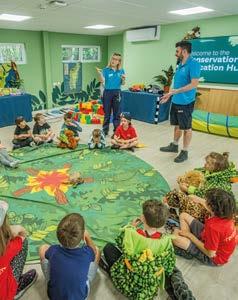
Media and outreach expansion
In addition to traditional classrooms, the hub also includes a sound-proofed studio space equipped with technical resources for creating various media content. This strategic addition allows for live streaming of lessons globally and the creation of online lectures, thereby broadening outreach efforts. The studio not only supports formal educational programmes, such as the Postgraduate Certificate in Conservation and Sustainability Education in conjunction with the University of Chester, but also empowers learners to share conservation messages through their own media projects.
Community engagement
As part of the Conservation Education Hub project, an adjacent area was redeveloped and included the establishment of a new play area to encourage children’s connection to nature. Additionally, the hub is now home to activities supported by by various organisations, including the Holiday Activity Fund and the Chester Bluecoat Charity –ensuring educational opportunities are accessible to all.
Outcomes
The investment in the Conservation Education Hub and the surrounding area has significantly impacted education and training at Chester Zoo. Creating these high quality spaces for learning has improved our ability to engage with educational visitors and community groups, deliver training and work with young people through our volunteering, childcare and youth programmes.
CASE STUDY
34 | Annual Report 2023 Impact Report

Conclusion
The establishment of the Conservation Education Hub at Chester Zoo reflects our commitment to conservation education, outreach and community engagement. The hub’s success underscores its pivotal role in nurturing future conservationists and promoting sustainability initiatives.

The Studio has already been used by young people completing the volunteering element of their Duke of Edinburghʼs Award with us. In addition to developing skills and completing their hours as visitor engagement volunteers in the zoo, these young volunteers also create their own conservation advocacy projects. Following masterclasses with our digital learning team, the young volunteers (aged between 14 and 16) created podcasts, posters and short films to share their passion for conservation with their peers, extending their message beyond the zoo.



Key colleagues
Many of the education and engagement programmes hosted within the Conservation Education Hub, including our new Ofsted registered childcare activities, are devised by our Zoo Ranger team, led and supported by Visitor Engagement Manager, Olivia Neville.
Lauren Walker and David Hughes use their creative media expertise to enable us to make the most of the new Studio space, enhancing our educational and volunteering offer for young people and supporting our team to bring digital technologies into their teaching.
We had
122,983 educational visits
We had
34,614 students taught on site
We had 10,699 students taking part in outreach projects
We had 26,824 volunteer hours donated We had 1,999 young people taking part in our dedicated youth programmes
35 chesterzoo.org
Olivia Neville Lauren Walker David Hughes
Impact on Scientific research
Protecting the eastern black rhino
Overview
Chester Zoo’s sustained efforts over 15 years have been dedicated to the conservation of the critically endangered eastern black rhino. Through extensive research and innovative scientific techniques, the zoo has not only contributed significantly to the understanding of rhino physiology but has also extended its expertise to support conservation efforts in the wild, particularly in Kenya.
Research and scientific contributions
At the heart of Chester Zoo’s efforts lies the only zoo-based wildlife endocrinology lab in Europe. Here, scientists have developed novel techniques to track hormones, effectively gaining insights into reproductive health and success in the eastern black rhino. The analysis of tens of thousands of faecal samples has provided key knowledge to aid in managing the care and breeding of the species in zoos across Europe. In 2023, the zoo collected 536 samples for analysis, helping to time breeding introductions and monitor pregnancies, resulting in the birth of the 12th calf born since the inception of the research programme.
Extending expertise to conservation
The zoo’s expertise has transcended zoo boundaries, benefiting eastern black rhino populations in Kenya.
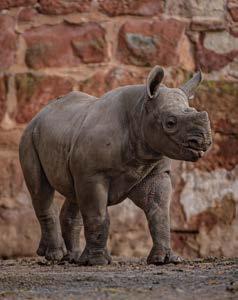
Collaborations with the Kenyan government and in-country partners have facilitated the application of scientific tools to support the management of rhino populations in the wild. This includes the processing of black rhino faecal samples in a Kenyan laboratory, aiming to integrate physiological monitoring into black rhino conservation management, further contributing to the sustainability of the species.
Conclusion
Chester Zoo’s unwavering commitment to the research and conservation of the eastern black rhino has yielded significant outcomes, not only within zoo settings but also in the wild. The collaborative efforts and scientific contributions have demonstrated a true one-plan approach, with the potential to further bolster the critical population of the eastern black rhino, ensuring its survival and wellbeing both in captivity and in its natural habitat.
Increasing population numbers of the black rhino since 2000.
400 600 800 1000 2000 2001 2002 2003 2004 2005 2006 2007 2008 2009 2010 2011 2012 2013 2014 2015 2016 2017 2018 2019 2020 2021
CASE STUDY
36 | Annual Report 2023 Impact Report
eastern black rhinos have been born at Chester Zoo since 2008.



Key colleagues
In 2023, the rhino team collected 536 samples from our four adult females here at Chester Zoo, which were analysed every month by our Lab Technician, John O’Hanlon, to help time breeding introductions and diagnose and monitor pregnancies.
For several years, Dr Katie Edwards, Rebecca Mogey and Dr Sue Walker from our Science department have been working closely with the Kenyan government and several in-country partners to apply the same scientific tools that we use to support the species in zoos to help inform eastern black rhino management in the wild.
Over 600 professionals learning through our Conservation Training Academy
Over 500 genetic samples cryopreserved in a living biobank
Partnerships with 15 universities
39 Chester Zoo Conservation Scholars and Fellows
293 science outputs, including 31 peer-reviewed publications and 100 scientific presentations
11
37 chesterzoo.org
John O’Hanlon Dr Katie Edwards
Impact on Public health and wellbeing Nature Recovery Corridor (NRC) project
Overview
In May 2023, Chester Zoo completed its Nature Recovery Corridor (NRC) project, aimed at restoring wildlife-rich habitats and empowering the community with naturerelated knowledge and skills to enhance both wildlife and human wellbeing.
Project implementation and outcomes
Spanning 19 months, the project improved 62 hectares for wildlife, creating eight ponds, 24 hectares of wildflower meadows and 15 hectares of grassland. Involving over 12,000 participants and local groups, including community, mental health and refugee organisations, the project aimed to provide inclusive opportunities for nature engagement and wellbeing benefits. The project was informed by evidence demonstrating the mental health benefits of contact with nature, incorporating various activities such as physical and mental exercises, social connections, learning and mindfulness.
Assessing impact
Qualitative interviews with 32 participants revealed positive outcomes across health and wellbeing, knowledge and understanding, and connection to nature. Participants expressed feelings of increased mental wellbeing, freedom and improved mental health through their engagement with nature. A subsequent quantitative survey indicated that 82% of participants reported improved wellbeing, 78% felt a stronger connection to nature and 84% gained new knowledge about

wildlife and habitat management. The survey also found that 45% of participants reported health benefits from their involvement.
Community engagement
The NRC project’s impact on community wellbeing was evident through positive feedback from Chester West Communities Together, highlighting the beneficial impact on residents’ health and wellbeing, particularly for those previously lacking opportunities to connect with nature and wildlife.
Future directions
Building on the success of the NRC project, Chester Zoo is leading the development of the Networks for Nature (NFN) project, with a greater focus on health and wellbeing. Partnerships with medical practitioners and local prescribers will explore different models for nature and wellbeing activities, while funding from the Westminster Foundation and Chester Bluecoat Charity supports the delivery of family wildlife clubs and nature interventions for children and young people and their families.
Conclusion
The Nature Recovery Corridor project not only achieved significant ecological restoration, but it also effectively improved the wellbeing of local communities. It serves as a testament to the transformative power of connecting with nature and underscores the potential for future projects to integrate nature and wellbeing interventions.
CASE STUDY
38 | Annual Report 2023 Impact Report

What people say about us...
I love nature, especially since [the] pandemic, and it just opens up the doors to you to know that there is a life out there with nature to connect to, and it just makes you feel alive and feel healthy in one way. It’s mental wellbeing.



Key colleagues
A multidisciplinary team, made up of staff from the zoo’s Conservation Education and Engagement and Field Programmes teams, delivered the NRC project. Our Community Engagement Manager, Hannah Brooks, co-ordinated the development of the project and its evolution into Networks for Nature.
Charlie Dale, Community Engagement Officer, has worked with a wide range of community groups to find new ways to build the scientifically evidenced five ways to wellbeing and five pathways to nature connectedness into our education and engagement programmes.

I have to say again, yes, it’s all been positive because of my ongoing issues that I have with my mental health. It’s been great to get outside, appreciate nature and basically just get back to basics, as to what’s all around us every day.
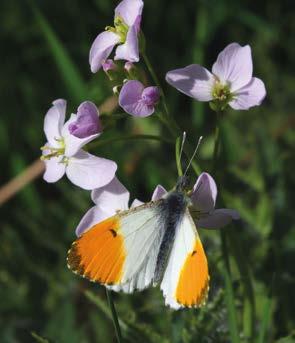
16 different employee wellbeing related activities took place
433 people took part in family wildlife clubs
32 staff attended mental health awareness training
82% of participants in our Nature Recovery Corridor project reported improved wellbeing
45% of participants in our Nature Recovery Corridor project reported positive health benefits
39 chesterzoo.org
Hannah Brooks Charlie Dale
Impact on Conservation outreach Mangabe landscape, Madagascar
Overview
Our conservation project in Madagascar spans 27,349 ha of mixed farmland and forest in Mangabe and is aimed at connecting wildlife habitats and restoring 5,000 ha of forest by 2026. We collaborate with Madagasikara Voakajy (MV), whose Director, Julie Razafimanahaka, received the prestigious Tusk Award for Conservation in Africa in 2021.
Reforestation efforts
In 2023, we planted 24,087 native tree seedlings across eight degraded locations, with five sites designated for passive restoration. Reforestation surveys indicate an impressive 80% survival rate, benefiting wildlife – especially lemurs. To adapt to shorter wet seasons, we identified fruit-retaining species in May to address climate change impacts on lemurs. Passive acoustic monitoring devices have been employed to survey lemurs, minimising disturbance to their populations.
Collaborative capacity building
Chester Zoo staff actively engaged with 30 Malagasy nursery workers and two zoo garden team members to enhance tree propagation for reforestation. The workshop identified 46 improvements, empowering nurserymen to enhance production for the coming year.

Community prosperity and sustainable farming
MV collaborates closely with local communities to promote sustainable farming and diversify livelihoods, particularly among young people. By 2023, MV’s ‘Youth for Lemurs’ project had 233 members in 21 groups practising sustainable farming on 31 demonstration plots. Seventy per cent of young participants adopted improved farming techniques on their land. Teams received training in entrepreneurship, cooperative management and marketing, resulting in the establishment of five legally recognised youth cooperatives.
Chester Zoo expedition (January 2023)
Mangabe hosted a Chester Zoo staff expedition involving 15 members from various departments. Activities included freshwater fish surveys, unveiling a potential new-to-science fish from the Rheocles spp. genus. The team installed a water well, solar pump and sanitary facilities in collaboration with the local community. Training in guiding, public engagement and marketing was delivered to community guides, preparing for ecotourism development. Community-based conservation education sessions were conducted in the new visitor information centre, and the team planted 3,150 native trees at one of MV’s reforestation sites.
CASE STUDY
40 | Annual Report 2023 Impact Report
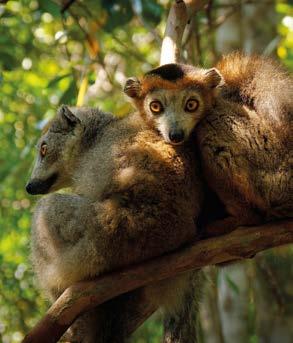
Additional achievements during 2023
We have also made significant progress with our many other field conservation projects around the world, where we:
• Enabled our field partners in Malaysian Borneo to connect two patches of forest by planting over 70,000 trees, forming a wildlife corridor for orangutans and other species thanks to generous support from our corporate partners, Co-op, Saputo Dairy UK and Asda.
• Collaborated with the IUCN Conservation Planning Specialist Group, facilitating a workshop for Mexico’s Goodeid fish, resulting in a 10-year action plan.
• Contributed to human–wildlife conflict and co-existence science, publishing a UN FAO and IUCN case study on de-escalating conflict between tigers and people in India.
• Launched a Darwin Initiative funded project for transboundary collaboration with partners in India and Nepal to manage human–tiger co-existence.



Key colleagues
Regional Programme Manager Claire Raisin leads our collaborative conservation outreach work in Madagascar, including our partnership with Madagasikara Voakajy (MV). Claire worked with Project Officer Charles Wheeler to lead and organise our zoo expedition to Mangabe in January 2023. Later in the year, we hosted Silver Tsy Lavina from another of our partners, the Madagascar Flora and Fauna Group, for a skills exchange at Chester Zoo. Silver gained valuable skills from a variety of activities supported by the Tony Williams Award, set up in honour of the late Tony Williams, a previous Chair of the Trustee Board.
Invested £1,116,768 in direct conservation action in the field
Funded 57 projects in 20 countries across our six regions in partnership with 62 organisations
Led 8 conservation planning workshops to facilitate conservation action
Nurtured partnerships to facilitate nature recovery in 146,000ha of landscapes
Actively worked to halt/reverse the decline of 55 species in the wild
41 chesterzoo.org
Claire Raisin Charles Wheeler
Impact on Economy Supporting the local area
Overview
Chester Zoo is a renowned conservation and education charity. Beyond delivery of its charitable objects, Chester Zoo exerts a significant economic influence in both its local area of Cheshire West and in the North West region of the UK.
Chester Zoo’s economic impact is multifaceted.
It drives significant spend and employment in the local economy. The zoo welcomes 2 million visitors each year and employs over 1,000 members of staff at peak times. Our economic influence extends to nearby businesses, including hotels, restaurants, retail shops and transportation services, which benefit from the influx of tourists drawn to the zoo.
Supporting local businesses
The zoo’s economic impact extends to supporting small and medium-sized enterprises (SMEs) in the area too. Local suppliers and producers often supply food, merchandise products, animal feed and bedding, building materials or services sold or used within the zoo premises, fostering entrepreneurship and small-scale manufacturing.
One such example is a new initiative with a local distillery called Sea Ridge. Sea Ridge are based just 19 miles from the zoo and have created five unique grain-to-glass spirits for Chester Zoo – vodka, rum and three gins – all using botanicals from the zoo estate for us to sell. This is a new initiative but has seen promising results since its launch.
Another example is our relationship with Gwynedd Confectioners, who are based 46 miles from the zoo. Chester


Zoo has worked with this family business for several years now and the business has steadily grown for both parties, with the zoo selling close to 30,000 of their chocolate items in 2023.
IP Jones are a local fencing contractor that have supported the zoo for over a decade. They have not only installed hundreds of metres of fencing but have also supported us with civil engineering projects across site. The fencing not only keeps our animals, plants and visitors safe but also ensures we remain fully compliant with our zoo licence.
An increasing local workforce
The zoo is a notable job creator, employing a diverse workforce spanning zoologists, educators, scientists, leisure and hospitality operators, maintenance workers and a wide range of support personnel.
In the last 10 years, Chester Zoo has employed over 250 extra members of staff to support its growth and delivery of its mission, which will increase by around 60 in 2025 when the overnight stays development and Heart of Africa open. Twothirds of our employees live in our local authority of Cheshire West and Chester, and our annual payroll is now close to £24 million.
CASE STUDY
42 | Annual Report 2023 Impact Report

A key driver for tourism in the region
Chester Zoo’s significance as a tourist attraction amplifies tourism in the region, encouraging overnight stays and extended visits. Local hospitality businesses experience heightened demand, with hotels, bed and breakfasts, and vacation rentals benefiting from increased occupancy rates, particularly during peak seasons. Restaurants and cafés in the vicinity also profit from heightened foot traffic, catering to both zoo visitors and residents.
We work closely with both Marketing Cheshire and Destination Chester, supporting an integrated destination management strategy for the area. Collaboration with other local leisure and hospitality businesses is also essential to create a compelling regional offer.
Improving our local community
Chester Zoo’s economic contributions extend to supporting wider community development. Collaborating with local authorities, other businesses and nearby communities, we enhance public spaces and drive initiatives to improve biodiversity both on our own estate and in our local area. This work enhances the quality of life for residents and brings additional investment into our region.
In summary, Chester Zoo’s economic influence transcends its role as a wildlife conservation hub and educational charity. Through its diverse economic activities, job creation, tourism promotion and support for local businesses, the zoo plays a vital role in driving economic growth and prosperity within its vicinity. By fostering collaboration, innovation and sustainable development, Chester Zoo continues to be a cornerstone of the regional economy, enriching both the community and the environment.


Key colleagues
Our Food & Beverage and Retail Product Managers, Laura Howley and Vicky Powell, work with our suppliers to curate highquality ranges with a focus on Chester Zoo’s sustainability principles. By reusing materials, collaborating with suppliers, often local to the zoo, and focusing on products that limit their impact on the planet’s resources, we are helping to shape best practice in product development for zoos and visitor attractions. We have some really amazing products and partnerships, all contributing to our mission of preventing extinction. This commitment shines through in the zooʼs menus, particularly at The Oakfield and The Square, where locally sourced produce takes centre stage, spotlighting our efforts to support and showcase local suppliers while maintaining sustainability standards.
146,232 members
149,878 visitors to Lanterns and Light
661 FTE employees
24 apprentices
£21.2m capital investment
43 chesterzoo.org
Laura Howley Vicky Powell
Impact on Policy
Lobbying for sustainable trade policy
Chester Zoo has a long history of campaigning to promote sustainable palm oil, which is a way of producing palm oil that ensures minimal impact on wildlife and the environment in the regions in which it is grown.
What was the problem?
In March 2023, the UK Government announced its intention to sign up to the Comprehensive and Progressive Agreement for Trans-Pacific Partnership (CPTPP) trade bloc. As part of this deal, it was announced that import tariffs on Malaysian palm oil would be reduced from 12% to zero, with no distinction made between forest risk and sustainably sourced palm oil. At the same time, the promised new regulations designed to force companies to avoid unsustainable products had still not been introduced. An opportunity to align imports of Malaysian palm oil to sustainable practices that prevent further deforestation and loss of wildlife was therefore in danger of being missed.
How did Chester Zoo tackle this issue?
We set about using our growing influence in Westminster and Whitehall to help shape political debate. We wrote to and met with parliamentarians to brief them on our concerns and supported MPs to table questions in the House of Commons. We also worked closely with partner organisations, including NGOs such as WWF and corporate supporters like Ferrero UK, to call for the introduction of new forest risk commodities regulations without further delay and also for the UK to use its trade policy to promote sustainable palm oil.
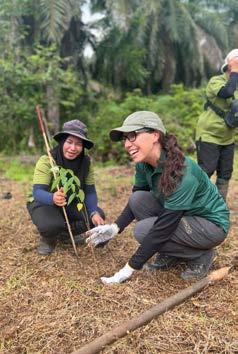
What did we achieve?
Chester Zoo’s arguments were put forward during debates in both Houses of Parliament. We also met with the International Trade Minister and senior CPTPP negotiators. The Minister confirmed that, in response to the representations made by environmental organisations like Chester Zoo, the UK would be publishing a new agreement with Malaysia designed to promote sustainability and efforts to prevent deforestation. When the CPTPP Bill came before parliament, we worked closely with former International Environment Minister Lord Goldsmith and NGO partners to promote an amendment that would force the government to regularly review the impact of its new trade deal on deforestation. The amendment received widespread support and was endorsed by the Labour Party, Liberal Democrats and the Green Party.
As a result, the government clarified the timeframe for bringing forward its new deforestation regulations, committed to reviewing the impact of CPTPP on deforestation and promised to involve experts such as Chester Zoo in this process. These concessions represented significant progress, and we’re continuing to work with supporters in parliament to influence proceedings, as well as seeking further opportunities to encourage politicians from all parties to work towards using UK trade policy to promote environmental sustainability and protect wildlife.
CASE STUDY
44 | Annual Report 2023 Impact Report


Additional achievements during 2023
• We had a high profile presence at both the Conservative and Labour Party conferences, where we hosted successful fringe events and engaged with MPs and peers on a range of environmental topics at our awardwinning stand.
• We continued to influence and engage industry and the private sector on sustainable supply chains for commodities that contribute to global deforestation, such as palm oil, through expert advice and contributions to international meetings and conferences.
• We are working with our local authority in Chester to shape the Local Nature Recovery Strategy for Cheshire.
• We played an active role in Wildlife and Countryside Link, the coalition body of environment and wildlife charities in the UK, helping to shape their Nature 2030 campaign to persuade all political parties to put nature at the centre of their manifestos for the next General Election.


Key colleagues
Our Public Affairs team, led by Gareth Siddorn, have developed strong connections with UK parliamentarians from all parties through a range of activities and events. The Public Affairs team were instrumental in pursuing the CPTPP issue through some of these connections and preparing briefing documents and drafting parliamentary questions and amendments to legislation. These were informed by our Deforestation-free Commodities Policy Lead, Cat Barton, who provided expert advice and evidence.
There were 19 stakeholder visits to the zoo
Chester Zoo was directly mentioned 13 times in parliamentary debate
We made 13 submissions to government consultations
Chester Zoo representatives attended 46 events involving policymakers
We gave 48 briefings to MPs and peers
45 chesterzoo.org
Gareth Siddorn Cat Barton

Did you know?
Did you know that we’ve now contributed over 500 samples to a living biobank? These samples are cryopreserved, preserving valuable genetic diversity that can be used in future conservation breeding programmes.
46 | Annual Report 2023 Strategic Report
Our leadership, governance and charitable purpose 48 Youth Board 54 S172 statement 56 Trustees’ responsibilities 60 Governance 47 chesterzoo.org
Our leadership, governance and charitable purpose
The North of England Zoological Society (‘the Charity’ or ‘Chester Zoo’) is the official registered charity name for Chester Zoo. As well as undertaking all of Chester Zoo’s charitable activities, it is the parent company to a number of wholly owned subsidiaries that have been incorporated for specific reasons, including one trading company, three dormant companies and a company that oversees the Charity’s defined benefit pension scheme (see note 24 of the financial statements).
The Charity is regulated by its Memorandum and Articles of Association, which are available for public inspection at Companies House.
Our charitable objects
Chester Zoo’s charitable objects, which set out why we were established as a charity, are laid out in our governing documents. The objects are:
• To promote the conservation of the physical and natural environment by promoting biodiversity.
• To advance the education of the public on the conservation of the physical and natural world and the promotion of biodiversity, in particular by, but not limited to, the provision of public education, scientific study and the maintenance of endangered animals, plants and habitats in both protective and natural environments.
Examples of the impact of our charitable objects can be found on pages 30–45 of this report.
Our governance structure
Chester Zoo operates a two-tier board structure, with a Trustee Board and a team of executive directors, a common structure typical of many UK-registered charities.
The Trustee Board
How many Trustees are there and how are they appointed?
Our governing documents set out the requirements for Trustees. There must not be less than three or more than sixteen Trustees. Of these, no more than thirteen can be elected Trustees and no more than three can be co-opted Trustees.
Elected Trustees, who must be members of Chester Zoo, are elected by the members at the Annual General Meeting and are Trustees for a maximum of six years. Co-opted Trustees are co-opted by the Trustees and may serve for up to 15 months from being appointed. Co-opted Trustees often go
on to become elected Trustees. Similarly, elected Trustees may be co-opted at the end of their six-year term and could subsequently go on to be re-elected by the members.
The Chair and Vice Chair are elected by the Trustees from their current membership and take the role for up to three years. At the end of the three years, they can be re-elected for a maximum of three further years. During their time as Chair or Vice Chair, they are not required to retire as Trustees in accordance with the normal six-year rule.
Who determines the responsibilities of the Trustee Board?
Our Trustees, in their capacity as directors, have responsibilities under charity and company law. The Trustees have ultimate responsibility for the activities of Chester Zoo and hold it ‘in trust’ for current and future beneficiaries.
Our Trustee Board fulfil these responsibilities by:
• Ensuring that there is a clear mission and strategic direction, in line with the charitable objectives, and that Chester Zoo is focused on achieving these
• Overseeing the performance of Chester Zoo, its employees and its culture
• Ensuring that Chester Zoo complies with legal and regulatory requirements
• Acting as guardians of Chester Zoo’s assets, both tangible and intangible, taking all due care over their security, deployment and proper application
• Ensuring that Chester Zoo’s governance is of the highest possible standard
How frequently does the Trustee Board meet and what is discussed?
The Trustee Board meets on a formal basis at least six times a year and has a rolling business cycle that is used to set the agenda for each meeting. Meetings, which are also attended by the executive directors and members of the Youth Board, are generally held as hybrid meetings, with Trustees encouraged to attend in person where practicable.
Board meetings have standing agenda items that are discussed at each meeting, including Health & Safety, Financial Performance, Safeguarding and any claims or legal matters. At each meeting, the executive directors all give an update on their team’s work and there is a report from the chair of each subcommittee.
In addition, there is a rolling business cycle of matters covered at least once a year. It includes approval of the annual
48 | Annual Report 2023 Governance
budget, an annual health and safety review, a review of the risk management strategy and a risk register. Once a year, a strategic review meeting is held where longer-term strategic direction is discussed.
At each meeting, at least one significant additional topic is presented for debate, discussion or approval. In 2023, these included final approval of Heart of Africa and the overnight stays development capital development, a review of the
animal and plant collection plan, a presentation on Chester Zoo’s brand, a review of the charity’s work with young people, an update on changes to the Secretary of State’s Standards of Modern Zoo practice and an update on the progress towards sustainability targets.
There are a number of subcommittees of the Board that meet regularly during the year.
Shaping our work with young people
In July 2023, the Director of Conservation Education presented the Board with an update on the zoo’s approach to youth engagement. Following this, there was a discussion on the organisation’s overall approach to working with young people, with a focus on outcomes for young people and organisational benefits, as well as benchmarking against other organisations in the sector. Particular attention was given to connectivity between the Youth Board – the Trustee Board’s advisors on matters impacting young people – and the wider organisational approach to youth governance. Going forward, consideration will be given to the appointment of a youth trustee and ensuring that young people are fully engaged with the governance of the organisation.


49 chesterzoo.org
Who was a member of the Trustee Board during this reporting period?
The table below sets out who our Trustees were during the year, how many Board meetings they attended (some having only been appointed in June 2023) and which Committees they were involved in.
Name Joining date Elected or co-opted
Malcolm Ardron – Chair November
Yvonne Emmett Cannell June 2023
Jen Carter*
Penny Coates – Vice Chair
Simon Cripps
Rhys Green
Griffiths
Dr Romain Pizzi
of Board meetings attended in 2023
Simon Venables
*Jen Carter is the Trustee Liaison to the Youth Board | **David Wooton acts as Chester Zoo’s Safeguarding Lead
Three Trustees, William Beale, David Chinn and Edwin Christmas, retired during the year and we thank them for their time, energy and input to the Board. Martin Harper, who was appointed during the year, retired in January 2024 due to a change in personal circumstances.
Committee membership Ethical Review Audit & Risk Management Remuneration Nominations Strategic Development Conservation Plan
Number
Elected 6 X X X X
2006
Elected 4 X X X
June 2019 Elected 5 X
June 2017 Elected 6 X Chair Chair Chair
Co-opted 3 X
Elected 5 X
Dr
June 2023
Professor
March 2022
Elected 6 Vice chair X Chair
Elected 5 X X
July 2022 Elected 5 X Lee
2019 Elected 4 X X
Professor Richard
November 2015
Professor David MacDonald March 2018
Rawlinson June
Elected 3 Chair Vice chair
Angela Robinson June 2023
Co-opted 4 Vice chair X
Neill Skinner June 2023
June 2014 Elected 6 Chair
March 2022 Elected 5 X X
David Wooton**
50 | Annual Report 2023 Governance
What do the subcommittees do?
The Trustee Board delegates aspects of their responsibilities to six subcommittees.
The Ethical Review Committee acts in an advisory capacity to the executive and the Trustee Board to ensure that the Society pursues its mission while adhering to the highest possible ethical principles as they apply to animals, people and wider conservation. The Committee met three times in 2023 and conducted independent reviews of a range of projects, both within the zoo and in overseas field programmes. This also includes projects conducted with valued partners, including universities, research institutions and conservation organisations around the world. In 2023, the Committee also conducted an in-depth review of its role and processes, which were found to be thorough and in line with its Terms of Reference. The Society’s ethical practices relating to business practice, sustainability and the environment, including matters relevant to the management of the zoo’s employees, were also reviewed as part of its rolling business cycle.
The Ethical Review Committee had three external specialist advisors in 2023: Professor Richard Preziosi, Professor Thomas Webb and Dr Lottie Hosie.
The Trustee Nominations Committee takes responsibility for ensuring that the Board has the relevant skills, experience, characteristics and backgrounds to provide high-quality, effective governance of the Society’s affairs. The Committee is responsible for identifying and proposing new Trustees to the membership for election at the Annual General Meeting. New Trustee roles are advertised through a number of channels, including the Society’s regular communications with its membership, the website and, increasingly, where specialist skills are sought, the use of executive search organisations. The nominations committee is also responsible for the induction, support and development of new Trustees.
The nomination committee met twice in 2023 to develop and conclude an approach for the recruitment of new Trustees. The Committee worked with Warren & Partners, an external search organisation to recruit new Trustees in 2023.
The Remuneration Committee is responsible for determining the remuneration of the Chief Executive Officer on behalf of the Trustees. Remuneration for other executive directors is set by the Chief Executive Officer in consultation with the remuneration committee and with external advice where necessary. The Remuneration Committee met three times in 2023 ahead of budget setting and to work with the CEO in setting a suite of objectives for 2024. Succession planning for the executive and senior management team was also a focus to ensure the continued delivery of strategic plans.
The Audit & Risk Management Committee is responsible for reviewing the effectiveness and integrity of the Society’s systems for internal control and its risk assessment procedures and appoints the Society’s external and internal auditors. The Committee met four times in 2023 and received reports from the external auditor on the 2022 financial statement and from the internal auditors who delivered an audit of the zoo’s staff training framework and completed a fraud risk assessment. The Society’s risk register was reviewed, and a number of presentations were made by management on topics such as data management and digital systems, interest rate hedging arrangements for the zoo’s borrowings, health & safety and IT security.
51 chesterzoo.org
The Strategic Development Committee is responsible for ensuring that the long-term Strategic Development Plan (SDP) for the physical development of the zoo estate is implemented in accordance with the strategy set out by the Trustees. The Committee monitors progress, scrutinises and makes decisions in respect of individual strategic capital projects in respect of the overall SDP with regard to quality, cost and overall programme and makes recommendations to the Trustee Board for any issues of significance in respect of the SDP and its implementation. The Strategic Development Committee met four times in 2023 and, through reports from project steering groups, monitored progress on the completion of The Square and the Conservation and Education Hub, alongside works on the new snow leopard habitat, Heart of Africa and the overnight stays development. The Committee also recommended the purchase of the 70-acre Ashton House farm and received presentations from the executive team on options for scaling up renewable energy generation on the zoo estate.
The Strategic Development Committee had two specialist advisors in 2023: Edwin Christmas and Mark Ditchburn.
The executive team
The Trustee Board delegates the day-to-day management of Chester Zoo to the executive director team, led by the Chief Executive Officer. The executive directors provide advice and information to the Trustee Board and attend all Board meetings and relevant subcommittee meetings.
The executive directors meet regularly as a group with the operational directors. Agendas include standing items such as health & safety, financial performance and review of the risk register, together with more strategic matters. In 2023, these strategic matters included planning for the next phase of the SDP, reviewing the results of the staff survey, incident management and long-term business planning.
All directors play active roles in project steering groups across the zoo, working closely with senior managers and delivering a directors’ engagement session to all staff each quarter.
The executive team at the date of this report and serving during the year were:
• Jamie Christon, Chief Executive Officer. Jamie is responsible for delivering the strategy for Chester Zoo and is accountable to the Trustee Board as Principal Executive. Jamie joined Chester Zoo in 2013 and was made CEO in 2021.
• Liz Carnie, Corporate Director. A Chartered Accountant by background, Liz is responsible for Finance, IT Operations, Health & Safety and Sustainability. Liz also oversees the zoo’s Facilities and Development teams. Liz joined Chester Zoo in 2014.
The Conservation Plan Committee provides oversight of the 10-year Conservation Plan, as approved by the Trustee Board, and assurance that it is being properly implemented in accordance with the strategic objectives and against measurable targets set for its delivery. The Conservation Plan Committee met three times in 2023 and used the conservation dashboard to monitor progress. The six targets are measured very differently, but in each case, the committee was able to see significant progress being made and is on track to achieving or exceeding the overall target by 2031, which coincides with the zoo’s centenary. The Committee has also started reviewing resources allocated to delivery and planning ahead to ensure that they will be sufficiently resourced to meet ambitions.
• Dr Simon Dowell, Conservation Science & Policy Director. Simon is responsible for the direction and delivery of the Conservation Plan, including our outreach in the field in 20 countries around the world and the scientific research programme that underpins the work we do towards our mission. Simon joined Chester Zoo in 2016.
• Mike Jordan, Animal & Plant Director. Mike leads all our animal and plant work in the zoo, responsible for the species we care for, the conservation breeding and propagation programmes and all the associated veterinary, logistics and technical services that support them. Mike previously worked at the zoo during the early 2000s and returned as director in 2015.
• Dominic Strange, Commercial Director. Dominic, who has significant experience in the leisure and attractions industry, leads the commercial strategy and oversees operations and marketing. Dominic joined Chester Zoo in 2010 and has led his teams through a period of significant growth in visitation.
The executive team are supported by five operational directors: Jen Atkins – Director of People & Culture, Sam
52 | Annual Report 2023 Governance
Hinchliffe – Director of Operations, Cathy Lunn – Facilities & Development Director, Kath Mainprize – Director of Marketing and Charlotte Smith – Director of Conservation Education.
Trustee induction and training Q&A with Penny Coates, Vice Chair of Trustees
Q: How do Trustees get started in their role?
A: Every Trustee begins their journey with a Trustee Handbook and a formal induction, which involves spending dedicated time with members of the zoo team.
Q: Are Trustees required to undergo any training?
A: Absolutely. Trustees are mandated to complete annual training sessions covering crucial topics such as Safeguarding, Cyber Security, Equality, Diversity and Inclusion.
Q: How do Trustees stay informed about changes in guidelines?
A: Trustees are regularly updated on any alterations to Charity Commission guidance. The Company Secretary delivers these updates at each Board meeting and, if necessary, outside of the regular meeting cycle.
Q4: Is there a safety net for Trustees in their roles?
A: Certainly. The Charity invests in liability insurance cover, extending protection to the Charity itself, its Trustees and other employees. This coverage includes safeguarding against damages, judgments, settlements or defence costs in case of legal actions.
External advice and assurance
The Trustee Board and executive team take external advice from a number of professional organisations including:
Company secretary
Aarco Services Limited, represented by Nick Clarke
External independent auditor
Grant Thornton UK LLP, Royal Liver Building, Liverpool L3 1PS
Internal independent auditor
RSM UK Risk Assurance Services LLP, 20 Chapel Street, Liverpool L3 9AG
Legal advisors
Aaron & Partners LLP, Grosvenor Court, Foregate Street, Chester CH1 1HG
Hill Dickinson LLP, No.1 St. Paul’s Square, Liverpool L3 9SJ
Knights plc, HQ Offices, 58 Nicholas Street, Chester CH1 2NP
Gunnercooke LLP, 53 King Street, Manchester M2 4LQ
Bankers
Santander UK plc, 7th Floor, 4 St Paul’s Square, Liverpool L3 9SJ
HSBC UK Bank plc, 47 Eastgate Street, Chester, Cheshire CH1 1XW
Lloyds Bank plc, 33 Old Broad Street, London EC2N 1HZ
Actuaries
Spence & Partners Limited, The Culzean Building, 36 Renfield Street, Glasgow G2 1LU.
53 chesterzoo.org
Youth Board
Established in 2020, with up to 18 volunteer members aged 18 to 26 years old, the Youth Board acts as a voice for young people within the zoo and for Chester Zoo on matters that impact young people, particularly in relation to youth voice in conservation decision-making. In particular, the Youth Board works to ensure that Chester Zoo is equipped to engage effectively with teenagers and young adults by offering advice and making recommendations to the Trustees and executive. Members of the Youth Board attend the Trustee Board meetings and are also invited to attend Committee meetings. The Youth Board met six times in 2023 and, during the same period, they:
• Spoke at two webinars organised by the IUCN National Committee for the UK – firstly, to speak about youth governance and best practices in engaging young people and, later, to join a panel of experts to discuss the future of conservation education and communication.
• Joined a round-table discussion about the development of the forthcoming Natural History GCSE, led by the exam board OCR.
• Worked with our Public Affairs team to host the Chester Zoo Youth Question Time event, providing an opportunity for young people to ask candidates questions in advance of elections for local councillors.
• Collaborated with the Conservation Education and Engagement team to lead a workshop on youth engagement for staff at the National Trust.
• Represented Chester Zoo, alongside the Conservation Education and Engagement team, in the Sustainability Hub at the Festival of Education and took part in a panel titled: Closing the Green Gap, helping students prepare for the jobs of the future.
• Joined Chester Zoo staff at our summer event for parliament staffers, giving a youth perspective on the event theme, ‘Connecting Westminster to Wildlife’.
• Participated in the annual Trustee Strategy Days.
• Curated and hosted the third Chester Zoo Youth Symposium, bringing together 126 young conservationists from across the UK for a weekend of inspirational youth-led talks, workshops and panel discussions.
• Worked with the zoo team to launch our first newsletter for young people who have taken part in youth programmes at Chester Zoo.



54 | Annual Report 2023 Governance
Preventing extinction
by empowering future generations
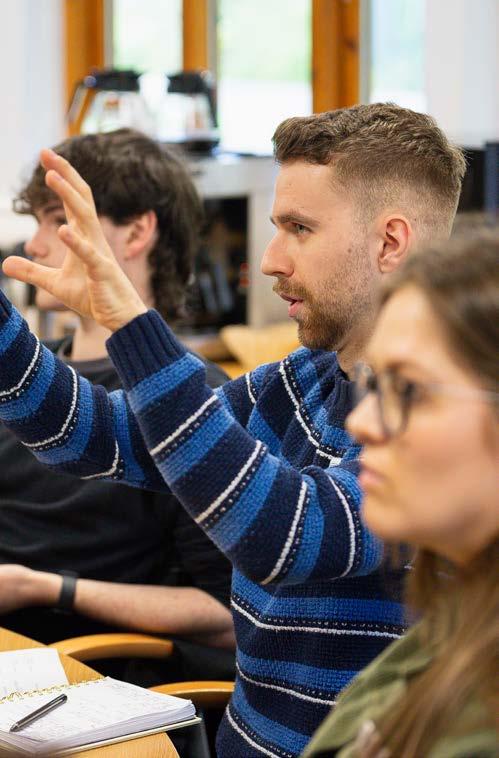
As Chester Zoo’s Youth Board, our mission is to provide a voice for young people. We will ensure that Chester Zoo offers a universal experience, whether at the Zoo or in wider communities, that puts young people right at the heart of it. We will work to make sure the next generation are represented in conversation, are engaged with the work of Chester Zoo and are empowered to have an impact on the future of conservation, so that together we can all help to prevent extinction.
55 chesterzoo.org
S172 statement
The Trustee Board, as Directors of The North of England Zoological Society, are aware of their duty under section 172 of the Companies Act 2006 to act in the way which they consider, in good faith, would be most likely to promote the success of the charity in order for it to achieve its charitable objects. In particular, the Board acknowledges that its decisions have a long-term impact on Chester Zoo’s stakeholders, including its employees, and on the environment, the community and the zoo’s reputation for a high standard of conduct as a charity.
Trustees must also comply with section 4 of the Charities Act 2011, having due regard to public benefit guidance published by the Charities Commission, including its supplementary guidance on fee charging.
Governance and decision making
Impact on the environment
Reputation as a charity
Public benefit
Equality, diversity and inclusion Grant-making Fundraising Engagement with stakeholders
Governance and decision making
On pages 48–53 of this report, we have set out the governance structure of the Board and its committees, the executive director team and professional advisers, along with detail of matters considered.
The balance of skills, experience, knowledge and diversity amongst the Board, the director team and the Youth Board brings a variety of different perspectives to its discussions and enhances the Board’s decision-making process.
All decisions are made in support of the strategy and its objective to continue to build a strong, resilient and sustainable zoo that can maintain and develop its mission of preventing extinction throughout this decade and into the next.
Impact on the environment
On pages 26–27 of this report, there are details of how Chester Zoo is acting to reduce the impact of its activities on the environment, in line with the four sustainability targets set out in the Chester Zoo Sustainability Policy and Conservation Plan. Chester Zoo’s estate includes the zoo and a significant land holding surrounding the zoo itself. This land is used for operational purposes, including growing browse for the animals, for carbon storage and for the protection of biodiversity, and includes the zoo’s nature reserve.
Action to address the zoo’s impact on the environment took a significant step forward in 2023. The launch of the new Sustainability Policy refreshed and reaffirmed the strategic direction of the organisation to ensure the zoo is building
towards a sustainable future aligned to global standards and legislation. It introduced a fourth sustainability target on UK biodiversity gain and set out more detail on the objectives and targets for sustainability for the organisation.
A new governance structure was established to support the delivery of the sustainability programme, to embed sustainable practices and to engage and empower staff and volunteers to adopt more sustainable behaviours.
Commitments to sustainable energy and waste management were further strengthened with the development of an energy campaign, installations of solar PV and air source heat pumps and the opening of the new waste Resource Recovery Centre.
A forest risk commodities audit built on our approach to sustainable palm oil and expanded our focus to address other products that could cause deforestation, as part of a broader approach to sustainable procurement across our supply chain.
Efforts to enhance the conservation of UK biodiversity on our estate have continued, with monitoring identifying 64 new species and several rare species recorded on site.
Efforts to enhance conservation of UK biodiversity on our estate continued. The addition of new UK Biodiversity Gain sustainability target firmly embed our existing commitments to local biodiversity within our sustainability strategy. We continue to support the development of Cheshire’s Local Wildlife Recovery and working closely with local partners as part of wider local strategies for native wildlife. Our monitoring identified 64 new species and several rare species recorded on site. In total, as of 2023, 377 species have been recorded
56 | Annual Report 2023 Governance
on the zoo estate. Notable monitoring results in 2023 include the return to of White letter Hairstreak; Nathusius' pipistrelle recorded at the Nature Reserve; the first breeding records of Cetti's Warbler; Great Crested Newts and Common Toads confirmed to have populated the new Meadow's pond and records of species rare to Cheshire such as the Essex Skipper Butterfly; Plain Dark Bee (1st Cheshire record); Bulrush Veneer Moth; Maple Pug moth and Tiphia minuta (solitary wasp).
Reputation as a charity
Chester Zoo has a range of policies and procedures in place that provide clear guidance on expectations and requirements for those working with and for the charity. Areas covered include ethical practices, employment procedures, working practices, communications procedures, health & safety procedures, environment, and safeguarding and information governance.
All policies are reviewed and updated regularly, and a number are reviewed by the Audit & Risk Management Committee or Ethical Review Committee as standing items.
As Chester Zoo’s activities regularly involve its staff and volunteers working with children and vulnerable adults, there is a designated Trustee safeguarding lead and there is a designated safeguarding officer on site every day.
Public benefit
Chester Zoo relies on income from admission fees, food, beverage and retail sales and other charges to cover its operating costs and ensure the financial sustainability of the organisation. Alongside this, we are committed to ensuring that our services are as accessible as possible, including to those who may face financial and other barriers to participation.
To mitigate financial barriers and encourage attendance from underrepresented audiences, we operate a number of different schemes to offer discounted and free tickets to targeted groups. In 2023, 196,835 children aged 2 and under were admitted free of charge and 35,354 educational visits were made using our winter free tickets scheme for schools. In addition, we worked with 10,699 children and young people from 57 schools through our outreach projects, providing workshops in schools and facilitating a free visit to the zoo. Where those projects take place in areas of higher deprivation (measured by the percentage of pupils claiming free school meals), participating children were also gifted tickets to enable them to return to the zoo with their families. Forty-two community organisations were allocated tickets through our Charity Connections Scheme, enabling 3,610 of their service users to visit the zoo without charge. Forty-eight organisations
were allocated tickets for use during 2024.
Our wider community engagement work ranged from the delivery of wildlife and wellbeing clubs in community centres to supporting groups of young people with complex learning needs to take part in programmes about global conservation and careers. Thanks to support from the Westminster Foundation, in 2023, we recruited a dedicated Youth Development Co-ordinator to help expand our work with young people and a Schools Engagement Officer to enable us to continue long-term packages of support for local schools, particularly enabling them to improve their playgrounds for wildlife, building on the work done with six schools through our Nature Recovery Corridor project which concluded in 2023.
We actively support people looking to gain experience in conservation and zoo-related careers, from teenagers completing the volunteering element of their Duke of Edinburgh’s Award (18 new students across the year) to earlier career conservationists being supported to study for their PhDs (39 supported during the year). We also offer apprenticeships, voluntary work placements and volunteering opportunities across a range of roles. During the year, we engaged 228 volunteers in in-zoo activities and a further 52 were supported to act for conservation in their community, through activities such as planting, pruning and habitat creation. All volunteers are supported to develop skills, make social connections and contribute to our charitable objectives in a way that works for them. Support volunteers are further trained to take on roles enabling volunteers with additional needs to volunteer in a supported way.
Online resources and digital tools enable a far wider range of people to engage with our work. In 2023, this included the addition of the Wild Wander app, which is free to download and is designed to enable people in the local community to explore the wildlife areas on their doorstep and to connect with nature.
Our nature reserve is open to all for free throughout the year and, in September, over 4,000 people attended our free Wildlife Connections Festival.
Equality, diversity and inclusion
Chester Zoo is committed to fostering a culture of equality, diversity and inclusion in the workplace and will continue to focus on this as part of our overall people strategy. In 2024, a key focus area will be reviewing policies to ensure they are inclusive, continuing to recruit from diverse pools and further developing our people to increase their awareness of the importance of Equality, Diversity and Inclusion.
In 2023, 30 staff members undertook Autism Awareness training as part of our ED&I (Equality, Diversity and Inclusion)
57 chesterzoo.org
training offering. All of our people complete mandatory e-learning on Unconscious Bias and ED&I.
We continued to employ 24 apprentices in 2023 as part of our efforts to diversify entry routes into conservation, and we facilitated 39 work experience students.
We also launched our LGBTQ+ and disability & neurodiversity staff and allies networks. As well as this, we participated in Chester Pride, with over 100 staff members, friends and family attending, and in Manchester Pride, with over 40 staff members, friends and family attending.
Grant-making
Chester Zoo supports a wide range of conservation and research activities both in the zoo and externally, often in partnership with other organisations to whom we provide ongoing financial support. Grants towards scholarships are also awarded. Rather than providing one-off grants, the Charity works in partnership with other like-minded organisations with whom projects are co-developed in line with our mission and Conservation Plan.
Criteria for funding support for such projects include alignment with the Chester Zoo Conservation Plan, feasibility, expected conservation outcomes, qualification of project personnel, capacity building, benefits to local communities, relevance to other conservation initiatives of the zoo and regions or countries where the zoo already has a field conservation focus, links to species within the collection plan and opportunities for technical support from zoo employees.
Primarily, support is provided to those projects judged to have the potential to make a significant positive conservation impact and a contribution to one or more of the six targets of our Conservation Plan. Applications are requested to be made on our standard grant application forms, and these are reviewed internally against standardised criteria before a funding decision is made.
Fundraising
Chester Zoo is committed to making fundraising a fair, responsible and enjoyable experience for our supporters and those who fundraise on our behalf. We want people to feel connected to our work and understand the incredible impact their donations make.
We are wholly committed to best fundraising practice and, as such, we’re signed up with the Fundraising Regulator. Both the organisation and the fundraisers operating within it abide by the Code of Fundraising Practice. We do not undertake fundraising that we consider to be intrusive or not akin to the
inclusive culture of our safeguarding, and treating donors fairly is paramount to our work. We support people on their donation journey with us, in whatever capacity requested or needed, responding to the needs of the individual as per the Code of Fundraising Practice.
With relevant permissions, we communicate with our supporters, so any indicators of additional required care become apparent (such as bereavement or personal circumstances). We take measures to protect donors, including delaying the acceptance of gifts, returning gifts (cooling-off period), monitoring online giving for gifts made in error or malicious activity, and ensuring there is clear transparency as to where a gift will be used. If we believe an individual lacks sound capacity to make a donation, it will not be taken. Returned donations will be logged on our dedicated database, so we’re prepared if another donation is made or attempted, making a reasoned judgment and acting appropriately.
Supporters under the age of 16 must have explicit guardian approval and must be accompanied by their guardian during any telephone communications and during their fundraising. They will not receive any general fundraising communications from us.
We take all reasonable steps to ensure that supporters understand the context, implications and use of their donation and our campaigns are carefully managed to never place undue emotional pressure to donate.
The Charity did not receive any fundraising complaints in the year.
58 | Annual Report 2023 Governance
Engagement with stakeholders
Our stakeholders
Our employees and volunteers
Our members and supporters
Why we engaged with them
To allow us to recruit, develop, support and train the best, most passionate people in support of our mission.
How we engaged with them
In 2023, 78% of employees completed our staff survey.
All-staff communications for all employees and volunteers: from weekly newsletters to quarterly all-staff briefings with an opportunity to ask questions.
Staff Association: open to all staff, with directors and senior managers attending regular meetings.
Volunteers: all get daily briefings and give shift feedback. They all receive an annual satisfaction survey and individual annual reviews. Volunteers receive weekly email updates and are invited to participate in regular engagement sessions with staff.
The public and communities
To build lasting relationships with those who support us, providing them with opportunities to engage with our mission.
To build public awareness of our mission and to encourage engagement with the zoo.
All of our members received a welcome pack, the Our Zoo quarterly e-magazine and e-mail communications. Additional information is available on the website.
Members can visit the membership office in the zoo.
Other zoos and related professional organisations
Opinion leaders, policy setters and other influencers
To increase the impact of our work by working with others.
To bring about policy changes that support conservation and the protection of biodiversity.
Through advertising campaigns and press stories. Using our social media channels and the website. Through talks and information throughout the zoo site.
Outreach through schools and community partners.
Face-to-face meetings and update communications with local residents.
Communication through member organisations, e.g. BIAZA and EAZA conferences.
Direct communication and meetings with other zoos and related organisations.
Providing briefing notes on topical issues, suggesting parliamentary questions and amendments to legislation.
By responding to consultations and calls for evidence.
Face-to-face meetings in Westminster, parliamentary visits to the zoo and attending party conferences.
Taking part in NGO coalitions and joint campaigns.
Being present at events, conferences and report launches.
Influencing and supporting the lobbying efforts of BIAZA and other zoos.
59 chesterzoo.org
Trustees’ responsibilities
Statement of Trustees’ responsibilities
The Trustees (who are also directors of the North of England Zoological Society for the purposes of company law) are responsible for preparing the Trustees’ Annual Report (including the Strategic Report) and the financial statements in accordance with applicable law and regulation.
Company law requires the Trustees to prepare financial statements for each financial year. Under that law, the Trustees have elected to prepare the financial statements in accordance with United Kingdom Accounting Standards, comprising FRS 102 ‘The Financial Reporting Standard applicable in the UK and Republic of Ireland’ and applicable law (United Kingdom Generally Accepted Accounting Practice). Under company law, the Trustees must not approve the financial statements unless they are satisfied that they give a true and fair view of the state of the affairs of the charitable company and the Group and of the incoming resources and application of resources, including the income and expenditure of the charitable group for that period. In preparing these financial statements, the Trustees are required to:
• Select suitable accounting policies and then apply them consistently
• Observe the methods and principles in the Charities Statement of Recommended Practice (FRS 102)
• Make judgements and accounting estimates that are reasonable and prudent
• State whether applicable UK Accounting Standards, comprising FRS 102, have been followed, subject to any material departures disclosed and explained in the financial statements
• Prepare the financial statements on the going concern basis unless it is inappropriate to presume that the charitable group will continue in business
The Trustees are responsible for keeping adequate accounting records that are sufficient to show and explain the charitable company’s transactions and disclose with reasonable accuracy at any time the financial position of the charitable company and the Group and enable them to ensure that the financial statements comply with the Companies Act 2006.
They are also responsible for safeguarding the assets of the charitable company and the Group and hence for taking reasonable steps for the prevention and detection of fraud and other irregularities.
Disclosure of information to auditor
Each of the persons who are Trustees at the date of approval of this report confirms that:
• So far, as the Trustee is aware, there is no relevant audit information of which the Charity’s auditor is unaware.
• The Trustee has taken all the steps that they ought to have taken as a Trustee in order to make themself aware of any relevant audit information and to establish that the Charity’s auditor is aware of that information.
The confirmation is given and should be interpreted with the provisions of section 418 of the Companies Act 2006.
The Trustees are responsible for the maintenance and integrity of the corporate and financial information included on the charitable company’s website. Legislation in the United Kingdom governing the preparation and dissemination of financial statements may differ from legislation in other jurisdictions.
Independent auditor
A resolution to formally reappoint Grant Thornton UK LLP as independent auditors will be proposed at the Annual General Meeting.
The Trustees’ Report, made up of pages 5–62 and 90–97, was approved by the Trustees on 3 May 2024 and signed on their behalf by:
Malcolm Ardron Chair of Trustees
60 | Annual Report 2023 Governance
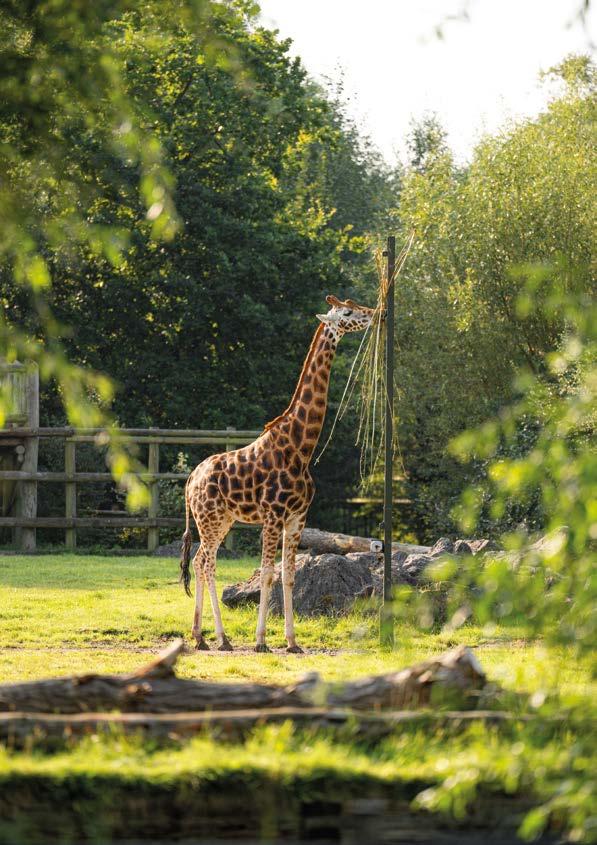
61 chesterzoo.org
Rothschild’s giraffe (Giraffa camelopardalis)
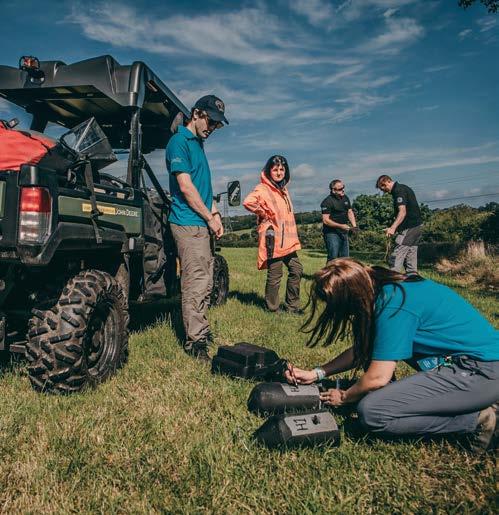
Did you know?
Did you know that last year we trained over 600 conservation professionals on courses and workshops run by Chester Zoo staff through our Conservation Training Academy?
62 | Annual Report 2023
Independent Auditorʼs Report and Financial Statements Independent auditor’s report 64 FINANCIAL STATEMENTS 68 Consolidated financial statements 68 Notes to the consolidated financial statements 76 63 chesterzoo.org
Independent auditor’s report
Independent auditor’s report to the members of The North of England Zoological Society
Opinion
We have audited the Financial Statements of The North of England Zoological Society (the ‘parent charitable company’ or ‘Society’) and its subsidiaries (the ‘Group’) for the year ended 31 December 2023, which comprise the Consolidated Statement of Financial Activities (including a Consolidated Income and Expenditure account), the Consolidated and Society Balance Sheets, the Consolidated Cash Flow Statement and notes to the consolidated Financial Statements, including a summary of significant accounting policies. The financial reporting framework that has been applied in their preparation is applicable law and United Kingdom Accounting Standards, including Financial Reporting Standard 102: The Financial Reporting Standard applicable in the UK and Republic of Ireland (United Kingdom Generally Accepted Accounting Practice).
In our opinion, the Financial Statements:
• Give a true and fair view of the state of the Group’s and parent charitable company’s affairs as at 31 December 2023 and of the Group’s incoming resources and application of resources, including its income and expenditure for the year then ended;
• Have been properly prepared in accordance with United Kingdom generally Accepted Accounting Practice including FRS102 ‘The Financial Reporting Standard Applicable in the UK and Republic of Ireland’ and the Statement of Recommended Practice: Accounting and reporting by Charities, 2019 edition; and
• Have been prepared in accordance with the requirements of the Companies Act 2006.
Basis for opinion
We have been appointed as auditor under the Companies Act 2006 and report in accordance with regulations made under that Act. We conducted our audit in accordance with International Standards on Auditing (UK) (ISAs (UK)) and applicable law. Our responsibilities under those standards are further described in the ‘Auditor’s responsibilities for the audit of the Financial Statements’ section of our report. We are independent of the Group and parent charitable company in accordance with the ethical requirements that are relevant to our audit of the Financial Statements in the UK, including the FRC’s Ethical Standard, and we have fulfilled our other ethical responsibilities in accordance with these requirements. We believe that the audit evidence we have obtained is sufficient and appropriate to provide a basis for our opinion.
Conclusions relating to going concern
We are responsible for concluding on the appropriateness of the trustees’ use of the going concern basis of accounting and, based on the audit evidence obtained, whether a material uncertainty exists related to events or conditions that may cast significant doubt on the Group’s and the parent charitable company’s ability to continue as a going concern. If we conclude that a material uncertainty exists, we are required to draw attention in our report to the related disclosures in the Financial Statements or, if such disclosures are inadequate, to modify the auditor’s opinion. Our conclusions are based on the audit evidence obtained up to the date of our report. However, future events or conditions may cause the Group or parent charitable company to cease to continue as a going concern.
In our evaluation of the trustees’ conclusions, we considered the inherent risks associated with the Group’s and parent charitable company’s business model, including effects arising from macro-economic uncertainties such as cost inflation and interest rates. We assessed and challenged the reasonableness of estimates made by the trustees and the related disclosures and analysed how those risks might affect the Group’s and parent charitable company’s financial resources or ability to continue operations over the going concern period.
In auditing the Financial Statements, we have concluded that the trustees’ use of the going concern basis of accounting in the preparation of the Financial Statements is appropriate.
Based on the work we have performed, we have not identified any material uncertainties relating to events or conditions that, individually or collectively, may cast significant doubt on the Group’s and parent charitable company’s ability to continue as a going concern for a period of at least twelve months from when the Financial Statements are authorised for issue.
Our responsibilities and the responsibilities of the directors with respect to going concern are described in the relevant sections of this report.
Other information
The other information comprises the information included in the Annual Report and Financial Statements, other than the Financial Statements and our auditor’s report thereon. The trustees are responsible for the other information contained within the Annual Report and Financial Statements. Our opinion on the Financial Statements does not cover the other information and, except to the extent otherwise explicitly stated in our report, we do not express any form of assurance conclusion thereon.
Our responsibility is to read the other information and, in doing so, consider whether the other information is materially
Financial Statements 64 | Annual Report 2023
inconsistent with the Financial Statements, or our knowledge obtained in the audit or otherwise appears to be materially misstated. If we identify such material inconsistencies or apparent material misstatements, we are required to determine whether there is a material misstatement in the Financial Statements themselves. If, based on the work we have performed, we conclude that there is a material misstatement of this other information, we are required to report that fact.
We have nothing to report in this regard.
Opinion on other matters prescribed by the Companies Act 2006
In our opinion, based on the work undertaken in the course of the audit:
• The information given in the Strategic Report and the Directors’ report, prepared for the purposes of company law, included in the Trustees’ Report for the financial year for which the Financial Statements are prepared is consistent with the Financial Statements.
• The Strategic Report and the Directors’ Report included in the Trustees’ Report have been prepared in accordance with applicable legal requirements.
Matter on which we are required to report under the Companies Act 2006
In the light of the knowledge and understanding of the Group and parent charitable company and their environment obtained in the course of the audit, we have not identified material misstatements in the Strategic Report or the Directors’ Report included in the Trustees’ Report.
Matters on which we are required to report by exception
We have nothing to report in respect of the following matters where the Companies Act 2006 requires us to report to you if, in our opinion:
• Adequate accounting records have not been kept by the parent charitable company; or
• Returns adequate for our audit have not been received from branches not visited by us; or
• The parent charitable company’s Financial Statements are not in agreement with the accounting records and returns; or
• Certain disclosures of trustees’ remuneration specified by law are not made; or
• We have not received all the information and explanations we require for our audit.
Responsibilities of Trustees
As explained more fully in the Statement of Trustees’ Responsibilities set out on page 60, the trustees (who are also the directors of the charitable company for the purposes of company law) are responsible for the preparation of the Financial Statements and for being satisfied that they give a true and fair view, and for such internal control as the trustees determine is necessary to enable the preparation of Financial Statements that are free from material misstatement, whether due to fraud or error.
In preparing the Financial Statements, the trustees are responsible for assessing the Group and the parent charitable company’s ability to continue as a going concern, disclosing, as applicable, matters related to going concern and using the going concern basis of accounting unless the trustees either intend to liquidate the Group or parent charitable company or to cease operations, or have no realistic alternative but to do so.
Auditor’s responsibilities for the audit of the Financial Statements
Our objectives are to obtain reasonable assurance about whether the Financial Statements as a whole are free from material misstatement, whether due to fraud or error, and to issue an auditor’s report that includes our opinion. Reasonable assurance is a high level of assurance but is not a guarantee that an audit conducted in accordance with ISAs (UK) will always detect a material misstatement when it exists.
Misstatements can arise from fraud or error and are considered material if, individually or in the aggregate, they could reasonably be expected to influence the economic decisions of users taken on the basis of these Financial Statements.
Irregularities, including fraud, are instances of non-compliance with laws and regulations. The extent to which our procedures are capable of detecting irregularities, including fraud, is detailed below:
• We obtained an understanding of the legal and regulatory frameworks applicable to the Group and parent charitable company, and the industry in which it operates, and determined which may influence the Financial Statements. Given the nature of its operating activities, the Group and parent charitable company is subject to several laws and regulations where the consequences of non-compliance could have a material effect on amounts or disclosures in the Financial Statements.
• We determined that the following laws and regulations are the most significant which are directly relevant to specific assertions in the Financial Statements:
65 chesterzoo.org
- Those that relate to reporting frameworks being FRS 102 and the Statement of Recommended Practice (‘Charities SORP (FRS 102)’), the Charities Act 2011, the Companies Act 2006 and the relevant tax compliance regulations.
- Those that relate to the operational activities of the Group and parent charitable company as a zoo being the Zoo Licencing Act 1981, including subsequent amendments; health and safety requirements of the animals, visitors and employees; data protection and bribery and corruption practices.
• We assessed the susceptibility of the Group’s and parent charitable company’s Financial Statements to material misstatements, including how fraud might occur. We performed the following audit procedures to address the risks related to irregularities and fraud:
- Evaluation of the processes and controls in place to address the risks related to irregularities and fraud;
- Challenge of the assumptions and judgements made by management in its significant accounting estimates;
- Review of performance targets and conditions to funding received and their propensity to influence efforts made by management to manage earnings;
- Review and testing of journal entries, in particular manual journal entries including those with unusual account combinations, journals relating to management estimates and journal entries impacting the reported result for the year;
- Consideration of the potential for fraud in revenue recognition through the manipulation of revenue from membership income, cut off in respect of visitor admissions and events income and revenue recognised through an unusual account combination;
- Identifying related parties and through our data interrogation tools performed a review for any related party transactions in the year.
• We have enquired of management, the compliance officer, the Audit and Risk Management Committee and the internal auditors whether there was any awareness of instances of non-compliance with laws and regulations or whether they had any knowledge of actual or suspected fraud. We corroborated the results of our enquiries with supporting documentation such as board minute reviews.
• In assessing the potential risks of material misstatements, we obtained an understanding of the Group’s and parent charitable company’s operations, the applicable statutory provisions and business risks that may result in risk of material misstatement, and the Group’s and parent charitable company’s control environment, including the adequacy for authorisation of transactions.
• These audit procedures were designed to provide reasonable assurance that the Financial Statements were free from fraud or error. The risk of not detecting a material misstatement due to fraud is higher than the risk of not detecting one resulting from error and detecting irregularities that result from fraud is inherently more difficult than detecting those that result from error, as fraud may involve collusion, deliberate concealment, forgery or intentional misrepresentations. Also, the further removed non-compliance with laws and regulations is from events and transactions reflected in the Financial Statements, the less likely we would become aware of it.
• The engagement team’s experience with similar engagements, their understanding and knowledge of the Group’s and parent charitable company’s industry and their understanding of the industry and regulatory requirements were considered in assessing the appropriateness of the collective competence and capabilities of the engagement team.
A further description of our responsibilities for the audit of the Financial Statements is located on the Financial Reporting Council’s website at: www.frc.org.uk/auditorsresponsibilities. This description forms part of our auditor’s report.
Financial Statements 66 | Annual Report 2023
Use of our report
This report is made solely to the charitable company’s members, as a body, in accordance with Chapter 3 of Part 16 of the Companies Act 2006. Our audit work has been undertaken so that we might state to the charitable company’s members those matters we are required to state to them in an auditor’s report and for no other purpose. To the fullest extent permitted by law, we do not accept or assume responsibility to anyone other than the charitable company and the charitable company’s members as a body for our audit work, for this report or for the opinions we have formed.
 James Bird, FCA Senior Statutory Auditor
James Bird, FCA Senior Statutory Auditor
for and on behalf of Grant Thornton UK LLP
Statutory Auditor, Chartered Accountants
Liverpool
Date: 3 May 2024
67 chesterzoo.org
Consolidated financial statements
Consolidated statement of financial activities (including a consolidated income and expenditure account) for the year ended 31 December 2023
The North of England Zoological Society reported an unconsolidated deficit of £527,000 before a Gift Aid donation from its trading subsidiary (2022: an unconsolidated surplus £1,411,000) which related to normal continuing operations.
No statement of changes in equity has been presented as all such gains and losses have been included above. The notes on pages 76–88 form part of these financial statements.
Financial Statements 68 | Annual Report 2023
Notes Unrestricted funds £’000 Restricted funds £’000 Total 2023 £’000 Total 2022 £’000 Income from: Charitable activities Visitor admission income 20,019 - 20,019 19,442 Membership income & related Gift Aid 12,299 - 12,299 10,756 Zoo events & experiences 2,658 - 2,658 2,002 Project grants & contributions - 830 830 469 Other charitable income 628 - 628 352 Total income from charitable activities 35,604 830 36,434 33,021 Donations and legacies Donations from zoo visitors & related Gift Aid 2,049 - 2,049 1,657 Animal adoptions 356 - 356 236 Legacies & other voluntary income & related Gift Aid 1,249 683 1,932 1,680 Total income from donations, grants & legacies 3,654 683 4,337 3,573 Trading activities Trading income – Chester Zoo Enterprises Limited 2 16,429 - 16,429 14,019 Total income from trading activities 16,429 - 16,429 14,019 Investments Investment income 3 188 - 188 67 Total income 55,875 1,513 57,388 50,680 Expenditure on: Raising funds Cost of generating memberships, donations & legacies 5a (2,464) - (2,464) (2,461) Cost of visitor admission & experience 5a (12,438) - (12,438) (8,842) Interest expense on borrowings to fund capital developments 5a (572) - (572)Movement in fair value of derivative 5a, 18 (476) - (476)Trading costs – Chester Zoo Enterprises Limited 2, 5a (15,510) - (15,510) (13,282) Total expenditure on raising funds (31,460) (31,460) (24,585) Charitable activities Habitats, species & populations 4, 5a (20,531) (815) (21,346) (20,148) Conservation education, engagement & capacity building 4, 5a (3,490) (596) (4,086) (3,824) Conservation advocacy 4, 5a (819) - (819) (691) Total expenditure on charitable activities (24,840) (1,411) (26,251) (24,663) Total expenditure (56,300) (1,411) (57,711) (49,248) Transfer between funds 142 (142) -Net (expenditure)/income (283) (40) (323) 1,432 Net movement in funds (283) (40) (323) 1,432 Reconciliation of funds 20 Total funds brought forward 62,981 896 63,877 62,445 Total funds carried forward 62,698 856 63,554 63,877
Consolidated and society balance sheets as at 31 December 2023
The Society reported a deficit for the year of £323,000 (2022: surplus of £1,411,000). The financial statements were approved and authorised by the Trustees on the 3 May 2024 and signed on their behalf by:
Malcolm Ardron, Chair of Trustees Company number 00287902 – The North of England Zoological Society
The notes on pages 76–88 form part of these financial statements.
69 chesterzoo.org
Consolidated Society Notes 2023 £’000 2022 £’000 2023 £’000 2022 £’000 Fixed Assets Intangible assets 10 80 479 80 479 Tangible assets 11 79,121 64,431 79,121 64,431 Investment in subsidiary companies 12 - - -79,201 64,910 79,201 64,910 Current assets Stocks 13 1,174 1,121 164 188 Debtors 14 1,829 2,085 2,330 2,834 Cash at bank and in hand 15 5,461 6,124 5,295 6,065 8,464 9,330 7,789 9,087 Creditors: Amounts falling due within one year 16 (11,761) (9,613) (11,127) (9,411) Net current liabilities (3,297) (283) (3,338) (324) Total assets less current liabilities 75,904 64,627 75,863 64,586 Creditors: Amounts falling due after more than one year 17 (12,350) (750) (12,350) (750) Net assets 63,554 63,877 63,513 63,836 Funds employed Income funds – restricted 20 856 896 856 896 Income funds – unrestricted 20 62,698 62,981 62,657 62,940 Total funds employed 63,554 63,877 63,513 63,836
Consolidated cash flow statement for the year ended 31 December 2023
The notes on pages 76–88 form part of these financial statements.
Financial Statements 70 | Annual Report 2023
Notes 2023 £’000 2022 £’000 Cash flows from operating activities: Net movement in funds as per the Statement of Financial Activities (323) 1,432 Adjustments for: Interest paid 572 150 Interest received (188) (67) Fair value of derivatives 476Amortisation charge 10 399 389 Depreciation charge 11 6,517 6,285 Loss on sale of fixed assets 21 84 Increase in stocks 13 (53) (201) Decrease/(increase) in debtors 14 256 (94) Increase/(decrease) in creditors due within one year 16 1,074 (219) Net cash generated from operating activities 8,751 7,759 Cash flows from investing activities: Interest received 188 67 Purchase of fixed assets (20,630) (5,023) Net cash used in investing activities (20,442) (4,956) Cash flow from financing activities: Cash inflows/(outflows) from borrowing 15 11,600 (250) Interest paid (572) (150) Net cash provided by/(used in) financing activities 11,028 (400) Change in cash and cash equivalents in the year (663) 2,403 Cash and cash equivalents at 1 January 15 6,124 3,721 Cash and cash equivalents at 31 December 15 5,461 6,124
Principal accounting policies
The following accounting policies have been applied in dealing with items that are considered material in relation to the financial statements of The North of England Zoological Society (‘the Charity’, ‘the Society’). They are consistent with those adopted in the financial statements for the prior year.
Basis of preparation
The financial statements have been prepared on a going concern basis under the historical cost convention and in accordance with applicable accounting standards in the United Kingdom. The financial statements comply with the Charities Act 2011, the Companies Act 2006, the Memorandum and Articles of Association, and Accounting and Reporting by Charities: Statement of Recommended Practice (‘Charities SORP (FRS102)’) applicable to charities preparing their financial statements in accordance with the Financial Reporting Standard applicable in the UK and Republic of Ireland (FRS102). The functional currency of the charity is sterling (£).
The Group’s activities, together with the factors likely to affect its future development, performance and position are set out in the Strategic report. The financial position of the Charity and its subsidiaries, its cash flows and liquidity position are shown in these financial statements.
Significant estimates and judgements made in preparing the financial statements are set out on page 75. The Strategic report also notes the principal risks and uncertainties that impact the Group.
The Charity has taken advantage of the exemption allowed from preparing a cash flow statement on the basis that it is a qualifying entity and the consolidated cash flow statement included in these financial statements includes the Charity’s cash flows.
Going concern
The financial statements have been prepared on a going concern basis. In determining the appropriate basis of preparation of the financial statements, the Trustees are required to consider whether the Charity and the Group can continue in operational existence for the foreseeable future.
Chester Zoo’s income in 2023 grew significantly, as did its cost base, reflecting ongoing inflationary pressure alongside an investment in both securing growth in income streams and in continuing charitable activities. With the significant investment in the Strategic Development Plan and capital expenditure of £21.2m, the Charity increased its borrowings in the period.
In 2024/25, Chester Zoo will continue to draw down on the banking facility with Santander, as the Heart of Africa and the overnight stays development projects move towards completion in spring 2025.
The £45m banking facility, secured in 2022 to fund these developments, is detailed in note 17 to the financial statements and following the year end, this facility was enhanced by a further £4.5m facility to provide additional funds to cover increases in the costs of these projects seen since they were originally approved in early 2023. The facilities are subject to two financial covenants which are tested quarterly: net debt to EBITDA (leverage) and EBITDA to net finance charges alongside a green loan covenant relating to the £15m development loan. The Group has generated sufficient income to meet the covenant tests during the year. Forecasts, together with reasonable sensitivity analysis on key assumptions, including a reasonable downside scenario for reduction in visitor numbers and potential increases in the cost of delivering capital projects, alongside mitigating actions to reduce discretionary expenditure, provide evidence to support the Trustees' view that the Group will continue to meet the covenant tests in the new facilities to at least 31 May 2025.
The Trustees consider that the Charity and Group are well placed to manage the risks within its control and mitigate those outside its control during a period of significant borrowings ahead of the completion of the Heart of Africa and overnight stays development in spring 2024. Despite there being net current liabilities at a consolidated level, this position will reverse as £3.9m of deferred income at 31 December 2023 (2022: £3.4m) is released in future periods. Forecasts, with sensitivity analysis on key assumptions such as reduced visitor numbers, zoo closure, capital project budgets and the ability to reduce spend quickly if required, support the Trustees' view that the group will continue to operate beyond 12 months from the date of signing of the financial statements. While there remain uncertainties outside the control of the Charity, there is sufficient headroom in the Charity’s £4.4m cash reserves and £49.5m banking facility to manage the current economic headwinds.
71 chesterzoo.org
After the review of the budget and predictions for the period to 31 May 2025, and having considered the uncertainties described above, the Trustees are of the opinion that the Charity and Group has adequate resources to continue in operational existence for the foreseeable future, being a period of not less than 12 months from the date of approval of these financial statements. Accordingly, they continue to adopt the going concern basis in preparing the financial statements.
Consolidation
The consolidated statement of financial activities (SOFA), consolidated balance sheet and consolidated cash flow statement include the financial statements of the Charity and its subsidiary undertakings, Chester Zoo Enterprises Limited and the North of England Zoological Society Pension Trustee Company Limited, made up to 31 December 2023 and comply with recommended practice for accounting by charities. The results of the subsidiaries are consolidated on a line-by-line basis. No separate SOFA has been presented for the Charity alone as permitted by Section 408 of the Companies Act 2006. Chester Zoo Hotels Limited, Chester Zoo (Nigeria) Limited and Chester Zoo Foundation Nigeria have not been included because they are dormant and not considered material to the Group.
Funds employed
All funds employed must be expended in furtherance of the objectives of the Charity. Restricted income funds must be used in furtherance of some specific aspect of those objectives.
Designated funds are those which have been set aside by the Trustees out of unrestricted funds for identifiable future expenditure, but the designation has an administrative purpose only and does not legally restrict the Trustees' discretion to apply the funds.
The unrestricted fund represents the funds to provide for the working capital of the Group and contingent expenditure.
Incoming resources
In accordance with the Statement of Recommended Practice (SORP), all incoming resources becoming receivable by the Group during the year are recognised in the SOFA, regardless of their source or of the purpose to which they are to be allocated. Income, both unrestricted and restricted, is recognised at the time of receipt, except where it relates to a service to be provided in the following financial year. Such income is deferred and released over the period the service is provided. An example of this is the treatment of annual membership income or deposits received ahead of events held at the zoo.
Where income is restricted to a specific purpose, as specified by a donor, the income is included in restricted funds. Legacies are recognised when payment is received or assets transferred, or where there has been a grant of probate and the executors have established that there are sufficient assets in the estate after meeting its liabilities to pay the legacy. Grants from government and non-government sources are recognised when there is entitlement, conditions have been met and there is certainty of receipt.
Resources expended
Expenditure is recognised when a liability is incurred. In accordance with the Charities SORP, support costs have been allocated to charitable activities and fundraising, apportioned by usage according to relative cost-driving activities. Support costs also include governance costs as a separate component in line with the Charities SORP. Governance costs comprise of all costs involving public accountability of the Group and its compliance with regulations and good practice.
VAT
Visitor admission income is treated as VAT exempt. Accordingly, the Charity is a partially exempt body and may not recover all VAT incurred on costs, with the exception of VAT incurred in connection with the catering, retail and event operations for which the sales are subject to VAT. These operate through the trading subsidiary Chester Zoo Enterprises Limited and the VAT directly related to these operations can be recovered in full. The Charity uses the standard method to calculate its residual input tax recovery. The cost of any irrecoverable VAT is apportioned in the SOFA under other resources expended. Any irrecoverable VAT relating to the purchase of fixed assets is capitalised as part of the asset value.
Financial Statements 72 | Annual Report 2023
Taxation
The Charity is considered to pass the tests set out in Paragraph 1 Schedule 6 Finance Act 2010 and therefore it meets the definition of a charitable company for UK corporation tax purposes. Accordingly, the Charity is potentially exempt from taxation in respect of income or capital gains received within categories covered by Chapter 3 Part 11 Corporation Tax Act 2010 or Section 256 of the Taxation of Chargeable Gains Act 1992, to the extent that such income or gains are applied exclusively to charitable purposes.
Investments in subsidiary undertakings
These are included at cost less any provision for impairment.
Intangible fixed assets
Computer software is included in the balance sheet at historic purchase cost, less accumulated amortisation. The amortisation rate reflects the useful economic life of the computer software.
Asset class
Computer software
Tangible fixed assets
Rate of amortisation applied
10% to 25% straight line
Tangible assets are included in the balance sheet at historic purchase cost less accumulated depreciation and any recognised impairment loss. Assets in the course of construction are stated at cost, less any recognised impairment loss.
Depreciation
The rates and method of depreciation are consistent with those used in previous years. Depreciation is calculated using a straight line basis. Freehold land is not depreciated and assets in the course of construction are only depreciated when the assets are ready for their intended use.
Asset class
Freehold properties
Buildings and enclosures
Machinery and equipment
Rate of depreciation applied
2% to 10%
4% to 25%
10% to 25%
Animals in the zoo’s care are generally either bred at the zoo or come to Chester from other zoos without charge and are held in trust. The animals and plants are held in the balance sheet at a nominal value of £1,000, and not depreciated, as a more realistic valuation cannot be attributed.
Impairment
The carrying amounts of assets are reassessed when impairment indicators are present. An impairment loss is recognised to the extent the carrying amount of an asset exceeds its estimated recoverable amount. The estimated recoverable amount is reviewed at subsequent balance sheet dates where further information is available.
Leases
All leases currently held by the Group are operating leases and the rental charges are taken as expenditure when incurred. The Group has not entered into any finance leases.
Stocks
Stocks are valued at the lower of cost and estimated net realisable value. Where necessary, provision is made for obsolete, slow moving and defective stocks.
73 chesterzoo.org
Pensions
The Group operates two voluntary pension schemes.
The Group makes contributions to a defined contribution pension scheme for all qualifying permanent employees and to the NEST scheme for all qualifying seasonal employees. Employees are automatically enrolled on the pension scheme unless the Group is notified by the employee that they wish to opt out. The cost of these contributions is charged to the SOFA when payable.
The defined benefit scheme was closed to future accrual in March 2012. The Group has historically made payments in order to reduce the scheme’s solvency deficit over time. These payments have been recognised within actuarial gains and losses in the net movement in funds in the SOFA. To the extent that the scheme is in surplus on a technical provision basis, the Group does not recognise this in the financial statements, as the Group is unable to recover any surplus either through reduced contributions in the future or through refunds from the scheme.
The trustee of the defined benefit scheme, secured member benefits with Aviva on 23 November 2021. While there remains no legal or constructive obligation to buy out the pension scheme, the payment and professional fees attributable to the transaction have been recognised in the SOFA as a settlement of the scheme within other expenditure. The policy with Aviva represents an asset within the scheme that is an insurance policy that exactly matches the amount and timing of all of the benefits payable under the plan. As a result, the fair value of the asset is deemed to be the present value of the obligations under the defined benefit plan.
Grant-making
The Group supports a wide range of conservation and research activities both in the zoo and externally, often in partnership with other organisations. Liabilities relating to grants are recognised once the Group is irrevocably committed to the provision of the grant.
Related party transactions
Details of transactions with related parties are disclosed in the notes to the financial statements.
Debtors
Trade and other debtors are recognised at transaction price, less any impairment.
Cash at bank and in hand
Cash at bank and in hand includes cash, overdrafts and short-term highly liquid investments with a short maturity of three months or less from the date of acquisitions, or opening of the deposit, or similar account.
Creditors
Creditors are recognised where the Group has a present obligation resulting from a past event that will probably result in the transfer of funds to a third party and the amount due to settle the obligation can be measured or estimated reliably. Creditors are normally recognised at their settlement amount after allowing for any trade discounts due.
Financial instruments
The Group primarily only enters into basic financial instrument transactions that result in the recognition of financial assets and liabilities, like accounts receivable and payable.
Financial assets that are measured at cost and amortised cost are assessed at the end of each reporting period for objective evidence of impairment. If objective evidence of impairment is found, an impairment loss is recognised in the SOFA.
Debt instruments (other than those wholly repayable or receivable within one year), including loans and other accounts payable, are initially measured at present value of the future cash flows and subsequently at amortised cost using the effective interest method. Debt instruments that are payable within one year, typically trade creditors, are measured, initially and subsequently, at the
Financial Statements 74 | Annual Report 2023
undiscounted amount of the cash or other consideration expected to be paid or received. However, if the arrangements constitute a financing transaction, the liability is measured, initially at the present value of future cash flows discounted at a market rate of interest for a similar debt instrument and subsequently at amortised cost.
For financial assets measured at cost less impairment, the impairment loss is measured as the difference between an assetʼs carrying amount and best estimate, which is an approximation of the amount that the charitable company would receive for the asset if it were to be sold at the balance sheet date.
Interest rate derivatives are classified as complex and are measured at their fair value at the balance sheet date with changes in fair value recognised against the surplus or deficit for the year.
Financial assets and liabilities are offset and the net amount reported in the balance sheet when there is an enforceable right to set off the recognised amounts and there is an intention to settle on a net basis or to realise the asset and settle the liability simultaneously.
Significant judgements
Preparation of the financial statements requires management to make significant estimates. The items in the financial statements where these estimates have been made include:
• Properties owned by the Group that are rented out: The Group owns a number of properties carried within tangible assets with a net book value of £271,000 (2022: £284,000) that are rented out. These properties are accounted for at cost less accumulated depreciation rather than as investment properties as the Group does not hold these properties for investment purposes. They are held in furtherance of the charitable purposes of the Group.
• Impairment of tangible fixed assets: Impairment tests will only be undertaken where there has been some indication that impairment has actually occurred. In a situation where the net book value of a tangible fixed asset will be greater than its recoverable amount, the value of the asset will be written down to this recoverable amount.
• Defined benefit pension scheme and buy-in with Aviva: As explained in note 24, the Trustees of the scheme secured a buy-in with Aviva. As at 31 December 2023, the Charity has not transferred its legal obligation in respect of the scheme to Aviva and has no legal or constructive obligation to do so. However, the Trustees of the scheme and the North of England Zoological Society triggered the wind up of the scheme with effect from 5 October 2022. The next stage of the process will be to convert the ‘buy-in’ policy to a ‘buy-out’ policy, which will see the Charity discharge its obligations in respect of the pension scheme and where each member of the scheme will have an insurance policy in their own name, covering the benefits due. The Trustees’ intention is to move towards a buy-out of the scheme.
Significant estimates
Preparation of the financial statements requires management to make significant estimates. The items in the financial statements where these estimates have been made include:
• Depreciation and amortisation rates: Depreciation and amortisation rates used in respect of both tangible and intangible assets reflect the expected useful life of those assets based on historic experience. For major projects, component parts are allocated varying depreciation rates depending on their nature. The depreciation and amortisation charge for the year ending 31 December 2023 was £6.9m.
• Defined benefit pension scheme: The scheme still remains the responsibility of the Group and the present value of the pension scheme asset depends on a number of factors that are determined on an actuarial basis using a variety of assumptions. The assumptions used in determining the net cost (income) for pensions include the discount rate. Any changes in these assumptions, which are disclosed in note 24, will impact the carrying amount of the pension liability. The Group has not recognised this pension scheme asset on the balance sheet as, despite the fact that as a result of the surplus, the Group is not currently making any contributions into the scheme, the scheme is closed to future accrual and the Group is not entitled to a refund from the scheme.
75 chesterzoo.org
Notes to the consolidated financial statements
1. Status
The Charity is a company limited by guarantee and has no share capital. Members have guaranteed the liabilities of the Charity to the extent of £1 each in the event of the charity being wound up. The registered address is Cedar House, Caughall Road, Chester CH2 1LH. The principal activity of the Charity is as a conservation and education charity that owns and operates Chester Zoo.
2. Trading activities
The Charity has a wholly owned trading subsidiary, Chester Zoo Enterprises Limited, incorporated in the UK (representing an investment of £100 in ordinary £1 shares) which operates the catering, retail and event activities of the zoo from outlets rented from the Charity. It distributes its annual taxable profit via Gift Aid to the Charity.
Audited financial statements for Chester Zoo Enterprises Limited for the year ended 31 December 2023 will be filed with the Registrar of Companies.
3. Investment income
Financial Statements 76 | Annual Report 2023
Chester Zoo Enterprises Limited trading results Total 2023 £’000 Total 2022 £’000 Trading income 16,429 14,019 Total income 16,429 14,019 Resources expended Labour and cost of goods sold (12,134) (10,426) Gross trading profit for the year 4,295 3,593 Indirect costs Operating and support costs paid to the Charity (3,376) (2,856) Property rents paid to the Charity (714) (716) Operating profit 205 21 Taxation -Profit for the financial year 205 21 Donation (payable) to parent under Gift Aid scheme (205)Profit retained in subsidiary - 21
Total 2023 £’000 Total 2022 £’000 Interest on cash deposits 188 67 Total investment income 188 67
4. Expenditure on charitable activities
5a. Analysis of total expenditure
5b. Analysis of support costs
77 chesterzoo.org
Total 2023 £’000 Total 2022 £’000 Habitats, species & populations • Priority species 13,008 12,345 • Visitor engagement species 5,274 4,990 • Conservation outreach programmes 1,155 1,144 • Science & research 1,909 1,669 Conservation education, engagement & capacity building 4,086 3,824 Conservation advocacy 819 691 Total expenditure on charitable activities 26,251 24,663
Employee costs Other direct costs Support costs (note 5b) Depreciation & amortisation Total 2023 Total 2022 £’000 £’000 £’000 £’000 £’000 £’000 Raising funds Costs of generating memberships, donations & legacies 473 394 1,321 276 2,464 2,461 Costs of visitor admission & experience 2,642 3,414 4,860 1,522 12,438 8,842 Interest expense on borrowings to fund capital developments 572 - - 572Movement in fair value of derivative - 476 - - 476Trading costs – Chester Zoo Enterprises Limited 5,440 6,694 3,376 - 15,510 13,282 Total expenditure on raising funds 8,555 11,550 9,557 1,798 31,460 24,585 Charitable activities Habitats, species & populations 7,089 3,702 6,336 4,219 21,346 20,148 Conservation education, engagement & capacity building 1,403 583 1,270 830 4,086 3,824 Conservation advocacy 148 88 514 69 819 691 Total expenditure on charitable activities 8,640 4,373 8,120 5,118 26,251 24,663 Total expenditure for Group 17,195 15,923 17,677 6,916 57,771 49,248
Total 2023 £’000 Total 2022 £’000 Direct employee costs 6,787 6,142 Other costs 10,830 9,415 Total of support costs 17,677 15,557
Support costs have been allocated to the activities set out in note 5a on the basis of their usage of cost-driving activities attributable to each support service, as follows:
6. Grants payable in furtherance of the Charity’s objectives
The Charity makes institutional grants payable in furtherance of the Charity’s objects to support field and zoo conservation and research. The grants have been included in the other direct costs analysis of total resources expended within the Statement of Financial Activities.
No allocation of support costs is required as all grants are issued directly to partners, with minimal employee or associated expenditure incurred in relation to the grant making activities.
7. Net income before other recognised gains and losses
This
8. Trustees’ remuneration
The Trustees, being charity Trustees, received no remuneration (2022: £nil) and six Trustees received reimbursement totalling £3,556 (2022: £1,361) for travel and accommodation expenses necessarily incurred. Indemnity insurance costing £33,600 (2022: £32,480) has been taken out by the Charity to protect the Charity, its Trustees and other employees.
Financial Statements 78 | Annual Report 2023
Support cost
by activity Costs of generating donations & legacies £’000 Cost of visitor admission & experience £’000 Trading costs –Chester Zoo Enterprises Limited £’000 Habitats species & population £’000 Conservation education, engagement & capacity building £’000 Conservation advocacy £’000 Total 2023 £’000 Total 2022 £’000 Governance 69 606 103 657 104 171 1,710 1,642 Marketing 683 855 615 461 231 231 3,076 2,329 Human resources 38 197 382 549 104 8 1,278 1,332 Information technology 57 292 568 815 154 11 1,897 1,592 Finance department 196 714 456 846 163 29 2,404 2,113 Site operations 23 202 396 219 34 5 879 906 Utilities 94 815 783 884 140 21 2,737 2,222 Facilities estates & development 161 1,179 73 1,905 340 38 3,696 3,421 Total 1,321 4,860 3,376 6,336 1,270 514 17,677 15,557
breakdown
Grants to institutions £’000 Grants to individuals £’000 Total 2023 £’000 Total 2022 £’000 Habitats, species & population 678 102 780 974 Conservation education & capacity building 33 - 33 26 Total grants payable 711 102 813 1,000
is after charging: Total 2023 £’000 Total 2022 £’000 Services provided by the Charity’s auditor Fees payable for the audit of the Charity and consolidated accounts 60 45 Fees payable for the audit of the subsidiaries 20 15 Fees payable for taxation compliance for the subsidiary 5 7 Operating leases 211 151 Amortisation of intangible fixed assets 802 389 Depreciation of tangible fixed assets 6,517 6,285 Derivative financial instrument loss 476 -
9. Employee costs
The average monthly headcount employed by the Charity during the year was 947 (2022: 873) including seasonal employees. The average monthly number of full-time equivalent employees (FTE) analysed by category were as follows:
The aggregate payroll costs of these persons were as follows:
The number of employees, including those employed for only part of the year, whose emoluments for the year (excluding employee pension contributions under salary sacrifice) fell within each band of £10,000 from £60,000 upwards is shown below. All of these employees had benefits accruing to them under the defined contribution pension scheme. Only one had benefits accruing to them on the defined benefit scheme. Contributions to the defined contribution scheme for all of these employees totalled £190,743 (2022: £128,318).
The key management personnel employed by the Charity comprise five members of the executive team who reported to the Trustee Board during the year. Their total employee benefits for 2023 including salary, bonus, pension contributions and employer’s National Insurance contributions were £674,635 (2022: £631,362).
79 chesterzoo.org
Number of FTE employees 2023 number 2022 number Habitat species & population 215 199 Conservation education 41 45 Conservation advocacy 3 3 Memberships donations & legacies 15 14 Visitor admission & experience 77 67 Trading subsidiary 150 131 Support & governance 160 149 Total FTE employees 661 608
Total 2023 £’000 Total 2022 £’000 Wages & salaries cost 20,326 17,949 Social security cost 1,635 1,503 Pension cost: • Defined contribution pension scheme 1,848 1,633 Total employee costs 23,809 21,085
2023 number 2022 number From £150,001 to £160,000 1From £140,001 to £150,000 - 1 From £100,001 to £110,000 1From £90,001 to £100,000 1 1 From £80,001 to £90,000 4 4 From £70,001 to £80,000 1 2 From £60,001 to £70,000 9 2
10. Intangible assets
11. Tangible assets
The Trustees consider that the Charity holds no fixed assets for investment purposes. While some of the fixed assets do yield a rental income, they were not acquired for that purpose but to facilitate the operation of the zoo, which is a primary charitable purpose of the Charity.
The Trustees consider that it is not meaningful to consider the market value of most of the Charity’s land and buildings. Where an assessment can be made, the Trustees consider that the market value exceeds the book value.
All the tangible fixed assets included in the consolidated statement above relate entirely to the Charity
The Charity considers that none of its assets meet the definition of heritage assets under FRS102. Although certain assets may have a heritage quality, these are all used for operational purposes in the running of the zoo and are therefore classified as operating assets.
Financial Statements 80 | Annual Report 2023
Computer software £’000 Total £’000 Cost At 1 January 2023 1,281 1,281 Additions -At 31 December 2023 1,281 1,281 Amortisation At 1 January 2023 802 802 Charge for the year 399 399 At 31 December 2023 1,201 1,201 Net book value At 31 December 2023 80 80 At 31 December 2022 479 479
Assets under construction £’000 Freehold property £’000 Buildings & enclosures £’000 Machinery & equipment £’000 Animals & plant collection £’000 Total £’000 Cost At 1 January 2023 5,855 5,150 102,703 15,604 1 129,312 Additions 18,302 965 708 1,254 - 21,228 Disposals - - - (27) - (27) Transfers (6,427) - 4,894 1,533 -At 31 December 2023 17,730 6,115 108,304 18,363 1 150,514 Depreciation At 1 January 2023 - 2,850 51,422 10,609 - 64,881 Charge for the year - 28 4,890 1,598 - 6,517 Disposals - - - (5) - (5) At 31 December 2023 - 2,878 56,313 12,202 - 71,393 Net book value At 31 December 2023 17,730 3,237 51,992 6,161 1 79,121 At 31 December 2022 5,855 2,300 51,281 4,994 1 64,431
12. Investments in subsidiary companies
The principal undertakings in which the Charity’s interest at the year end is more than 20% are as follows:
All the above undertakings are registered at Cedar House, Caughall Road, Upton-by-Chester, Chester CH2 1LH. Activities in Nigeria have now ceased and Chester Zoo (Nigeria) Limited and Chester Zoo Foundation Nigeria are now dormant.
13. Stocks
14. Debtors: amounts falling due within one year
Amounts owed by the subsidiary are unsecured, interest-free and repayable on demand.
81 chesterzoo.org
2023 £ 2022 £ Investment in Chester Zoo Enterprises Limited 100 100 Investment in Chester Zoo Hotels Limited 100Investment in Chester Zoo (Nigeria) Limited 1 1 North of England Zoological Society Pension Trustee Company Limited 1 1
Subsidiary undertakings Company number Country of incorporation Principal activity Class & percentage of shares held Group Company Chester Zoo Enterprises Limited 02669535 UK Catering and retail 100% ordinary 100% ordinary Chester Zoo Hotels Limited 14611700 UK Dormant 100% ordinary 100% ordinary Chester Zoo (Nigeria) Limited 08374657 UK Dormant 100% ordinary 100% ordinary Chester Zoo Foundation Nigeria 08904330 UK Dormant 100% ordinary -
Group Society 2023 £’000 2022 £’000 2023 £’000 2022 £’000 Goods for resale 891 834 -Consumables 283 287 164 188 Total 1,174 1,121 164 188
Group Society 2023 £’000 2022 £’000 2023 £’000 2022 £’000 Trade debtors 648 438 586 342 Amount owed by subsidiary undertaking - - 565 845 VAT & other debtors 81 151 81 151 Prepayments & accrued income 1,100 1,496 1,098 1,496 Total 1,829 2,085 2,330 2,834
15. Analysis of changes in net (debt)/funds
The cash held in escrow is set aside for the Trustee of the Charity’s defined benefit pension scheme and to be used to conclude the wind-up of the scheme (see note 24 for further details on the buy in of the scheme). The money would also be paid to the pension scheme if the Charity were to become insolvent.
16. Creditors: amounts falling due within one year
2022 comparative figures for both the Group and Society have been restated moving £201k from other creditors into deferred income.
Financial Statements 82 | Annual Report 2023
At 1 Jan 2023 £’000 Cash flows £’000 At 31 Dec 2023 £’000 Cash deposits 5,700 (521) 5,179 Cash held in escrow 424 (142) 282 Cash at bank & in hand 6,124 (663) 5,461 Bank overdraft - -Cash & cash equivalents 6,124 (663) 5,461 Revolving credit facility (750) (11,600) (12,350) Net (debt)/funds 5,374 (12,263) (6,889)
Group Society 2023 £’000 2022 restated £’000 2023 £’000 2022 restated £’000 Trade creditors 1,952 2,512 1,857 2,310 Other taxes & social security costs 480 393 480 393 Accruals 4,506 2,772 4,506 2,772 Other creditors 459 339 459 339 Fair value of derivatives 476 - 476Deferred income (see below) 3,888 3,597 3,349 3,597 Total 11,761 9,613 11,127 9,411
Balance at 31 Dec 2022 £’000 Utilised advanced purchases £’000 Advanced purchases £’000 Balance at 31 Dec 2023 £’000 Deferred income Memberships 2,841 (2,841) 2,944 2,944 Gift vouchers 120 (120) 143 143 Event deposits 175 (175) 330 330 Tickets 201 (201) 259 259 Experiences 260 (260) 212 212 Total deferred income 3,597 (3,597) 3,888 3,888 Balance at 31 Dec 2021 £’000 Utilised advanced purchases £’000 Advanced purchases £’000 Balance at 31 Dec 2022 £’000 Deferred income Memberships 2,752 (2,752) 2,841 2,841 Gift vouchers 191 (191) 120 120 Event deposits 61 (61) 175 175 Tickets - - 201 201 Experiences 333 (333) 260 260 Total deferred income 3,337 (3,337) 3,597 3,597
17. Creditors: amounts falling due after more than one year
The Charity’s borrowing arrangements, put in place on 30 March 2023, comprise two unsecured facilities: a £30m Revolving Credit Facility (RCF) and a £15m Business Development Loan. The new RCF facility expires in March 2028 and the Business Development Loan expires March 2027. Only the RCF had been drawn as at the balance sheet date. Both facilities bear interest at a margin of between 1.8% and 3.1% above SONIA, depending on leverage. To remain compliant with the terms of these facilities, the Charity needs to meet the following covenants:
(i) Interest cover – EBITDA must be at least four times the interest payable until 31 December 2024 and at least three times the interest payable until 30 June 2025 and to the maturity of the facilities; and
(ii) Leverage – The facilities bear a variable net debt requirement that must not exceed between 2.5 and 4 times EBITDA.
(iii) In respect of the business development loan, which is to fund the overnight stays development, the development is required to meet energy efficiency ratings for the loan to remain classified as a green loan.
18. Financial instruments
In order to mitigate some interest rate risk, the Charity entered into two interest rate hedging arrangements with Santander to protect from interest rate fluctuations in 2024/25 when the charity will have significant borrowings to fund the Heart of Africa and the overnight stays developments.
These arrangements comprise:
(i) An interest rate collar, with a notional amount of £15.0m linked to SONIA covering the period 31 January 2024 to 31 July 2025. The collar has a floor strike rate of 3.55% and a cap strike rate of 4.75%. At 31 December, this instrument had a fair value of £37,000.
(ii) An interest rate swap, with a variable notional amount of £5.0m–£15.0m covering the period 30 April 2024 to 30 June 2026. The swap exchanges a variable SONIA rate for a fixed rate of 5.096%. At 31 December 2023, this instrument had a fair value of £439,000.
Combined, these instruments provide hedging against interest rate fluctuations on over £15.0m–£30.0m of borrowings between 31 January 2024 and 20 June 2026. Their fair value of £476,000 in Santander’s favour will unwind over the coming years as interest payments are made under the arrangements.
19. Post balance sheet events
On 30 April 2024, the loan facility with Santander was extended by £4.5m for the period 1 December 2024 to 31 August 2025 to support completion of the Heart of Africa and the overnight stays development projects, bringing the total available finance facilities for that period to £49.5m. At the same time, covenant requirements for the period through to June 2026 were updated.
83 chesterzoo.org
Group Society 2023 £’000 2022 £’000 2023 £’000 2022 £’000 Revolving credit facility 12,350 750 12,350 750 Total 12,350 750 12,350 750
Group Society 2023 £’000 2022 £’000 2023 £’000 2022 £’000 Financial liabilities Financial liabilities measured at fair value 476 - 476 -
20. Movement in consolidated funds
Financial Statements 84 | Annual Report 2023
Balance at 31 Dec 2022 £’000 New funds £’000 Funds utilised £’000 Transfers £’000 Balance at 31 Dec 2023 £’000 Restricted funds Animal & plant collections 7 - (7) -Conservation science & education projects 464 1,513 (1,404) - 574 Escrow account – defined benefit pension scheme (note 15) 424 - - (142) 282 Total restricted funds 896 1,513 (1,411) (142) 856 Unrestricted funds Designated funds Funds tied to fixed assets 58,581 - (283) - 58,298 Total designated funds 58,581 - (283) - 58,298 Free reserves Cash reserve 4,400 - (142) 142 4,400 Total free reserves 4,400 - (142) 142 4,400 Total Group funds employed 63,877 1,513 (1,836) - 63,554 Balance at 31 Dec 2021 £’000 New funds £’000 Funds utilised £’000 Transfers £’000 Balance at 31 Dec 2022 £’000 Restricted funds Animal & plant collections 43 12 (48) - 7 Conservation science & education projects 472 926 (934) - 464 Monsoon Forest fire donations 106 - (106) -Escrow account – defined benefit pension scheme (note 15) 504 - - (80) 424 Total restricted funds 1,124 938 (1,088) (80) 896 Unrestricted funds Designated funds Funds tied to fixed assets 57,519 1,146 (84) - 58,581 Total designated funds 57,519 1,146 (84) - 58,581 Free reserves Cash reserve 3,802 518 - 80 4,400 Total free reserves 3,802 518 - 80 4,400 Total Group funds employed 62,445 2,602 (1,172) - 63,877
Restricted income funds include income from certain donations, grants and legacies received and money set aside in escrow for the defined benefit pension scheme (note 24).
Designated funds relate both to the movement in the Charity’s defined benefit pension scheme as it secured benefits with an insurer and to its intangible and tangible fixed assets which are used to carry out the Group’s activities. They have therefore been designated for that purpose.
The Charity sets aside a minimum £4.4m (2022: £4.4m) cash reserve, held separately from the Group’s other cash balances. Such a sum is sufficient to operate for a period of two months without significant curtailment of its activities.
21. Capital commitments
22. Leasing commitments
The Group’s future minimum non-cancellable operating lease commitments are as follows:
23. Related party transactions
The Charity will receive a charitable distribution by Gift Aid from Chester Zoo Enterprises Limited for the year ended 31 December 2023 of £204,868 (2022: £nil) before 30 September 2024. The Charity leases retail and F&B outlets to Chester Zoo Enterprises Limited and the 2023 lease costs were £714,375 (2022: £715,660). The Charity also charged staff and support costs totalling £3,374,621 (2022: £2,856,023). As at 31 December 2023, the Charity was owed £360,654 (2022: £844,893) from Chester Zoo Enterprises Limited.
85 chesterzoo.org Unrestricted Free £’000 Designated £’000 Restricted £’000 2023 total funds £’000 Fixed assets - 79,201 - 79,201 Current assets 4,400 3,208 856 8,464 Creditors: amounts falling due within one year - (11,761) - (11,761) Creditors: amounts falling due after more than one year - (12,350) - (12,350) Net assets 4,400 58,298 856 63,554 Unrestricted Free £’000 Designated £’000 Restricted £’000 2022 total funds £’000 Fixed assets - 64,910 - 64,910 Current assets 4,400 4,034 896 9,330 Creditors: amounts falling due within one year - (9,613) - (9,613) Creditors: amounts falling due after more
one year - (750) - (750) Net assets 4,400 58,581 896 63,877
than
Group Society 2023 £’000 2022 £’000 2023 £’000 2022 £’000 Capital expenditure, contracted for but not provided in the financial statements 15,340 3,917 15,340 3,917
Group Society 2023 £’000 2022 £’000 2023 £’000 2022 £’000 Within one year 93 48 93 48 Between one & five years 105 72 105 72 198 120 198 120
24. Pensions
The Charity operates two pension schemes: a defined benefit scheme and a defined contribution scheme.
Defined benefit scheme
The defined benefit scheme holds assets in a separately administered fund and closed to future accrual in March 2012.
On closing the scheme to future accrual in 2012, the Charity committed to funding the scheme on a solvency basis over a 10-year period and to work towards securing member benefits with an insurer and in November 2021, the Trustees of the scheme secured a buy-in with Aviva. The Charity contributed £2.1m, from funds held in escrow for the scheme, as part of the buy-in transaction. Professional fees of £142,000 (2022: £80,000) were also incurred in relation to this transaction.
The remaining escrow balance of £282,000 forms part of the Charity’s cash and cash equivalents balance (note 15) and is treated as restricted funds (note 20). This money will be used to fund the final wind-up of the scheme. The Trustee of the scheme and the Charity, triggered the formal wind up of the scheme with effect from 5 October 2022. The next stage of the process will be to convert the ‘buy-in’ policy to a ‘buy-out’ policy where each member of the scheme will have an insurance policy in their own name, covering the benefits due under the scheme.
A full actuarial valuation was carried out as at 31 December 2020 and updated to 31 December 2023 for the purpose of these disclosures by Spence & Partners Limited, qualified independent actuaries.
Net defined benefit asset/(liability) recognised - -
In line with FRS102, a surplus can only be recognised in the balance sheet to the extent that the Charity can gain economic benefit from it. As the scheme is closed to future accrual, a surplus can only be recognised to the extent of an agreed refund. There is no recognition of any surplus at the year end.
The major
made by the actuary for the defined benefit scheme were as follows:
Assumed life expectations on retirement at age 65:
Financial Statements 86 | Annual Report 2023
2023 £’000 2022 £’000 Present value of funded defined benefit obligations 12,577 11,744 Fair value of plan assets 12,709 11,835 Surplus 132 91 Effect of asset ceiling (132) (91)
assumptions
Weighted average assumptions used to determine benefit obligations at: 2023 2022 Discount rate 4.51% 4.77% Rate of price inflation (RPI) 3.26% 3.33% Rate of pension increases (5% RPI) 3.11% 3.16% Rate of pension increases (2.5% RPI) 2.11% 2.13%
Male member retiring today (member age 65) 22.6 22.5 Male member retiring in 20 years (member age 45 today) 24.3 24.2 Female member retiring today (member age 65) 25 25 Female member retiring in 20 years (member age 45 today) 26.7 26.6
The fair value of the plan assets were as follows:
87 chesterzoo.org
Fair value at 31 Dec 2023 £’000 2023 % Fair value at 31 Dec 2022 (£’000) 2022 % Cash & cash equivalents 132 1.03 91 0.77 Equities - - -Debt instruments - - -Insurance policy 12,577 98.97 11,744 99.23 Net current assets - - -Total 12,709 100.00 11,835 100.00 2023 £’000 2022 £’000 Change in defined benefit obligation Benefit obligation at beginning of year 11,744 17,455 Interest cost 549 322 Past service cost -Remeasurement: actuarial (gain)/loss 749 (5,234) Benefits & expenses paid (465) (799) Losses on settlements/curtailments -Benefit obligation at end of year 12,577 11,744 2023 £’000 2022 £’000 Change in scheme assets Fair value of scheme assets at beginning of year 11,835 17,455 Interest income 553 322 Employer contributions (incl. employer direct benefit payments) -Benefits & expenses paid (465) (799) Remeasurements – return on scheme assets less interest income 786 (5,143) Arrears allowance in respect of benefit rectification -Fair value of scheme assets at end of year 12,709 11,835
Expense recognised in the statement of financial activities
service cost
interest on net defined benefit obligation
Gains & losses on settlements and curtailments
Gains & losses due to surplus limitation
Defined contribution scheme
Contributions to the defined contribution scheme totalled £1,848,000 (2022: £1,633,000). The expenditure is taken from unrestricted funds.
Financial Statements 88 | Annual Report 2023 2023 £’000 2022 £’000
- -
-Past
- -
- -
Current
Net
service cost
- -
- -
Effect of changes in assumptions 380 (7,819) Effect of experience adjustments 369 2,585 Return on plan assets (excluding interest income) (786) 5,143 Remeasurement on effect of asset ceiling 37 91 Pension deficit reduction accrual -Total remeasurements included in other gains and losses in the SOFA -Total pension cost recognised in the pension scheme Professional fees on pension scheme buy-out 142 80 Total pension costs recognised in the SOFA 142 80
Total net interest cost
Remeasurements:

chesterzoo.org 89
Himalayan red panda (Ailurus fulgens fulgens)
Sustainability reporting
Carbon net zero
In 2023, we continued to decarbonise our activities towards our target to be carbon net zero in our scope 1 and 2 emissions by 2030 and carbon net zero in our scope 3 emissions by 2050 at the latest.
This included improving our data and reporting on greenhouse gas emissions, including estimating our scope 3 emissions.
The table below shows our estimated greenhouse gas emissions across scopes 1, 2 and 3.
1
Chester Zoo greenhouse gas emissions 2023
2
3
Scope 3
Chester Zoo Greenhouse Gas Emissions 2023. Scope 1 figure includes animal methane and carbon sequestered on zoo landholdings. Figures are rounded.
Regarding our progress towards our target to be carbon net zero in our scope 1 and 2 emissions by 2030, in 2023, our scope 1 and 2 emissions were estimated to be 3,718 tonnes of carbon dioxide equivalents (tCO2e) (excluding methane emissions from our animals). These emissions were primarily from our natural gas and electricity use, each representing 41% of overall scope 1 and 2 emissions. We have reduced our scope 1 and 2 emissions by 476 tCO2e (11%) on a 2019 baseline year, where scope 1 and 2 emissions were estimated to be 4,194 tCO2e (both excluding methane emissions from our animals).
In 2023, our scope 3 emissions were estimated to be 36,113 tCO2e. These emissions were primarily from our purchased goods and services, capital goods and visitor travel, representing 23%, 14% and 44% of our total emissions respectively.
Scope Emissions source Greenhouse gas emissions % of total greenhouse gas emissions
Natural gas use 1,626 tCO2e 4.06% Refrigerant gases 26 tCO2e 0.06% Other fuels 551 tCO2e 1.34% Fuel for fleet vehicles 72 tCO2e 0.18% Animal methane 210 tCO2e 0.53% Sequestration on landholdings -138 tCO2e -0.35%
Electricity use 1,597 tCO2e 3.99%
Purchased goods & services 9,159 tCO2e 22.87% Capital goods 5,424 tCO2e 13.55% Fuel and energy related activities 906 tCO2e 2.26% Upstream transportation & distribution 106 tCO2e 0.27% Waste generated in operations 1,731 tCO2e 4.32% Business travel 247 tCO2e 0.62% Employee commute 1,107 tCO2e 2.76% Visitor travel 17,433 tCO2e 43.54% Total 40,057 tCO2e 100% Figures
are rounded.
tCO2e
6%
1,597 tCO2e
4%
Scope 1 2,331
|
Scope 2
|
36,113 tCO2
90% 90 | Annual Report 2023 Governance
e |
In 2023, we continued our investment in decarbonisation towards our net zero target, including:
• Investing in solar PV – In 2023, we installed 42.5kWp of solar PV onto our new Science Centre (19.6kWp) and Conservation Education Hub (22.9kWp). In 2023, our existing solar PV installations on buildings generated approximately 209,000kWh of electricity to power the zoo.
• Decarbonising heat – In 2023, we installed four air source heat pump systems (153.5kW total capacity) as part of our strategy to move away from using fossil fuels. This includes our old rhino house and our new Science Centre, both of which are now being heated sustainably by air source heat pump systems.
Streamlined Energy and Carbon Reporting
This section sets out our disclosure in line with the Streamlined Energy and Carbon Reporting (SECR), for the reporting period 1 January to 31 December 2023.
Energy consumption
Chester Zoo’s energy use, within the United Kingdom, is set out below.

2023 2022 Energy usage 19,257,024 kWh 20,122,581 kWh
91 chesterzoo.org
The new air source heat pump system heating the Old Rhino House.
Greenhouse gas emissions associated with energy use
Chester Zoo’s greenhouse gas emissions, associated with its energy use in the United Kingdom, are set out below. Emissions source Scope
Gas consumption (gross CV)
consumption (gross CV)
Consumption of oil products (kerosene & white diesel) (gross CV)*
used in personal vehicles used for business travel (net CV)
*Oil products are used for heating and operational vehicles on site. Figures contain a small usage of fuel by equipment on site that cannot be disaggregated in the data. 2022 figures also contain use of red diesel fuel.
**In 2023, we improved our method to account for the vehicle size of personal vehicles for business travel to provide more accurate data.
The following table shows the greenhouse gas intensity ratios, based on the emissions data above, and the equivalent ratios for 2020, 2021 and 2022 for comparison. Figures are rounded.
Methodology
The greenhouse gas emissions reported above have been calculated using the Greenhouse Gas Protocol Corporate Accounting and Reporting Standard and the UK Government GHG Conversion Factors for Company Reporting. The organisational boundary has been set around the operational activities within the UK and at our operational zoo estate. We’re continuously improving our reporting and data, so our intensity metrics, presented above, have been refined to provide a direct comparison between years, based on the emissions sources in the table above.
Energy efficiency actions
In 2023, we continued to invest in energy efficiency on site, including LED lighting, insulation and measures to reduce heat loss in buildings. In addition, we delivered projects to install building mounted solar PV and air source heat pumps across site, to improve the carbon efficiency of our energy use.
Next steps
Looking forward, we continue to work to improve our reporting around our wider greenhouse gas emissions footprint (as reported in the Carbon net zero section above) and our wider environmental impact as an organisation.
We are also developing our strategy for delivering sustainability, notably publishing our new Sustainability Policy in 2023, to drive forward our action to address our greenhouse gas emissions and wider environmental impact as an organisation. This will include further investment in renewable and low carbon technology, increasing reuse and recycling rates and collaborating with supply chain partners on sustainability.
per acre of the total zoo
*In both 2020 and 2021, the zoo was closed to the public for a number of months due to COVID-19 lockdowns.
**In 2023, the zoo purchased an additional area of land, increasing
2023 emissions 2022 emissions
1 1,626 tCO2e 1,638 tCO2e
1 271 tCO2e 306 tCO2e
LPG
1 265 tCO2e 366 tCO2e Fuel use
1 72 tCO2e 72 tCO2e Purchased electricity 2 1,597 tCO2e 1,544 tCO2e Fuel
3 8 tCO2e** 5 tCO2e Total
3,838 tCO2e 3,931 tCO2e
in owned fleet (gross CV)
energy emissions
2023 2022 2021* 2020* kgCO2e
visitor
the year 1.98 kgCO2e 2.14 kgCO2e 2.51 kgCO2e 2.64 kgCO2e kgCO2e
estate 5,859 kgCO2e** 6,731 kgCO2e 6,873 kgCO2e 5,354 kgCO2e
per zoo
in
to
reduction of
the intensity metric per
the total zoo estate.
its zoo estate
265 ha. This has contributed to the
emissions under
acre of
92 | Annual Report 2023 Governance
Zero waste operation
In 2023, we continued to improve the management of our operational waste,* in line with our target of working towards a zero waste operation by 2030. The table below sets out our progress.

Deforestation-free commodities
Figures are rounded.
In 2023, our total tonnes of waste increased slightly, but not significantly, from 739 to 742 tonnes. Our reuse rate doubled to 2% and our recycling rate also improved from 38% in 2022 to 42% in 2023. As a result, use of incineration (energy from waste) reduced from 63% to 55%, showing significant progress on our journey towards zero waste. In 2023, during the infancy of our new management of carnivore and ape bedding, we disposed of 9 tonnes of waste to landfill, due to a process issue. We quickly implemented a solution, which has ensured the waste could be recycled.
In 2023, we made bold steps in our journey towards a zero waste operation, including:
• Our new Resource Recovery Centre became fully operational – a brand-new waste facility that increases our ability to segregate waste for reuse and recycling. The results are already being seen in our improved reuse and recycling rates above.
• Improving segregation of waste to improve reuse and recycling – most notably in our carnivore and ape bedding waste management. Previously this waste was incinerated, but by changing the way we collect and manage carnivore and ape bedding waste, it can now be processed and recycled as a soil improver. In 2023, 32 tonnes of carnivore and ape bedding waste was diverted from incineration into recycling.
*Currently, ‘operational waste’ excludes capital and maintenance, veterinary, laboratory and herbivorous waste streams, which are managed outside of our operational waste management contract. We’re working to include these in our waste reporting in future.
In 2023, we took strides forward towards our target to procure deforestation-free commodities in our major supply chains. The commodities we’re focusing on are cattle (beef and leather), cocoa, coffee, palm oil, timber, pulp and paper, and soy.
In 2023, we developed our approach towards a sustainable supply chain and deforestation-free products, including:
• Undertaking an audit of our major supply chains to understand the products we buy that could pose a risk to forests globally.
• Refining our internal policy, reporting and procurement processes to meet upcoming legislation on forest risk commodities.
• Hosting our annual Sustainable Supply Chain Innovation Day, bringing together our key suppliers to engage, share knowledge and collaborate on sustainable solutions across our supply chains.
• Continuing engagement and involvement with industry at a UK level to understand, collaborate and influence wider industry change.
2023 2022 Disposal Tonnes % of total operational waste Tonnes % of total operational waste Reuse 12 2% 7 1% Recycling 312 42% 281 38% Incineration (energy from waste) 409 55% 451 61% Landfill 9 1% 0 0% Total 742 100% 739 100%
93 chesterzoo.org
Waste compactor at Chester Zoo’s new Resource Recovery Centre.

UK biodiversity gain
In 2023, we continued to champion UK biodiversity across our estate, working towards our new sustainability target (launched in 2023) to achieve net gain for UK biodiversity, with 30% of zoo-owned land being managed for UK biodiversity by 2030. The table below sets out our progress by 2023 towards our target to have 30% of landholdings managed for UK biodiversity by 2030.
Land managed for UK biodiversity by 2023
Target of 30% of zoo-owned land managed for UK biodiversity by 2030
In 2023, 10% of zoo-owned land was being managed for UK biodiversity, a third of the way towards our ambitious target. Working closely with local conservation networks, and in synergy with the development of the Local Nature Recovery Strategy for Cheshire, we continue to enhance the zoo site to promote recovery of local species and habitats. Activities and management decisions are underpinned with robust monitoring and evaluation. In 2023, we evidenced
a range expansion and favourable population health of our reintroduced harvest mice and increases in breeding territories for several bird species. Extensive pond surveys also highlighted the positive impacts of our pond management, with the suite of ponds across our estate providing habitats for a range of locally and nationally threatened species, including the lesser silver water beetle and great crested newts.
In 2023, we continued to take action to protect and enhance space for UK biodiversity across our estate, including:
• Hedgerow assessments across our estate to inform future management plans and identify planting opportunities to fill hedgerow gaps.
• A full assessment of all ponds to understand their condition, which highlighted positive biodiversity gain from our management.
• Deepening of the main meadow Nature Reserve pond to improve water retention and establish it as year-round habitat.
• Grassland assessments across our estate, which evidenced that our nature reserve meadow continues to support increasing numbers and diversity of key species.
• Delivering orchard pruning workshops to manage the trees and upskill local communities in orchard management.
Area (hectares) % of zooowned land
26.2 10%
79.5 30%
94 | Annual Report 2023 Governance
Chester Zoo’s Sustainable Supply Chain Innovation Day held in November 2023.

95 chesterzoo.org
Chester Zoo’s Nature Reserve, part of the zoo landholdings managed for UK biodiversity.
Thank you
We could not achieve our mission without the support we receive from many individuals and organisations. Our thanks go to:
Trusts, foundations and grants
• Biodiversity Challenge Funds – Darwin Initiative, Defra
• Charles Brotherton Trust
• Chester Bluecoat Charity
• Marjorie Coote Animal Charity Trust
• Marsh Charitable Trust
• National Lottery Heritage Fund
• Oak Foundation
• Rainforest Trust
• Ronald and Kathleen Pryor Charity
• Sir Donald and Lady Edna Wilson Charitable Trust
• The National Archives – Archives Revealed Programme
• Westminster Foundation
• Whitley Fund for Nature
• William Dean Countryside and Educational Trust
Conservation, Science and Education corporate partners
• Asda
• Co-op
• Ferrero UK
• MBNA/Lloyds Banking Group
• Saputo Dairy UK
• The Mowgli Trust
• Urenco Ltd
UK Wildlife corporate champions
• Chester Racecourse
• Darwin Escapes
• Sykes Cottages Corporate champions
• Frontier Developments plc.
• M&S Bank
• Proximo Group
• Toyota UK
Gift in kind supporters
• Wienerberger UK
• Biocair
• Domainex
Major donors
• The Tony Williams Conservation Exchange Award**
• West Wallasey Van Hire
• LDRA Ltd
**The Tony Williams Conservation Exchange Award, which was set up in memory of a former Chair of Trustees of Chester Zoo, enables one Malagasy conservationist each year to
come to Chester Zoo for two months to undertake a tailored programme of personal development.
Legacies
Thank you to those who have kindly remembered us in their wills. These legacies are hugely valued and allow us to carry out our vital conservation work. This year we’d like to give a special mention to the following:
Graham Bancroft, who had been a member for many years and loved the zoo. Our heartfelt thanks go out to him and his family and friends for his incredible generosity in supporting our work.
Terri King (nee Mosiewicz) had a lifelong passion for wildlife and in particular big cats. She had visited the zoo since her childhood and was determined to use her legacy to help us conserve endangered species. We are so grateful to her and her family.
Mrs Betsy McCutcheon, who had long supported the zoo and adopted numerous species. We were most touched that she chose to remember us in her will and send our thanks to her and her family.
Academic partners
• Bogor Agricultural University
• Concepción University
• Durham University
• Imperial College London
• Indonesian Institute of Sciences (LIPI)
• Liverpool John Moores University
• Manchester Metropolitan University
• Nottingham Trent University
• Oxford University
• Turin University
• Universidad de Morelia
• Universidad Michoacana de San Nicolás de Hidalgo
• University of Cambridge
• University of Chester
• University of East Anglia
• University of Kent
• University of Liverpool
• University of Manchester
• University of Plymouth
• University of Sheffield
• University of the Philippines Diliman
• University of the Philippines Los Baños
• University of Toliara
96 | Annual Report 2023 Governance
Corporate collaboration highlights
• Announced first corporate sponsorship collaboration with Darwin Escapes dedicated to supporting our on-site British wildlife conservation.
• Secured a generous gift in kind donation from Wienerberger of rock and scree material for the snow leopard habitat.
• Urenco’s support enabled the transformation of the science laboratory.
• Held a sustainability-focused business networking and panel event in collaboration with Pro-Manchester.
• Two of the team from Mowgli visited the field programme in Borneo.
• Volunteering hours donated by corporate partners: 2,000+.
Run for Nature, our first in-house fundraising run, took place on 24 September with 1,000 runners taking part in our 10k race and a further 300 in our children’s Zoom. The event provided great exposure of the zoo as a charity and introduced our cause to new visitors taking part in the race. We were delighted that public fundraising by our runners totalled over £75,000, which will go towards our groundbreaking work on EEHV.

Chester Zoo was awarded a Partnership Grant from the Westminster Foundation to help young people young people tackle Britain’s disappearing wildlife. This new fiveyear partnership will see 4,500 children and young people participate in UK wildlife and conservation-focused education activities. The funding will enable the zoo to support ‘the next generation of conservationists’ to learn about conservation, experience the wellbeing benefits of connection to nature, lead positive change in their communities and broaden their career aspirations.
We were delighted to host the annual Cheshire Lieutenancy Dinner at The Square – this was an opportunity to welcome Deputy Lieutenants from across Cheshire and showcase the conservation work that happens on our doorsteps and across the globe.
 Great green macaw (Ara ambiguus)
Great green macaw (Ara ambiguus)
97 chesterzoo.org
Front and back cover image: Sumatran tiger (Panthera tigris sumatrae)

Registered Charity No. 306077 | Registered Company No. 287902 North of England Zoological Society, Caughall Road, Upton by Chester, Chester CH2 1LH | Tel: 01244 380280 Chester Zoo is licensed under the Zoo Licensing Act 1981. In the interests of conservation and educational study, this report may be freely copied without alteration or amendment and stored by electronic means without formal permission. It is also available to download from our website. Chester Zoo is happy to assist anyone with special needs obtain a copy in the appropriate format. Published May 2023 by the North of England Zoological Society.
to view the digital version of this report
Scan










 Christon Chief Executive Officer
Christon Chief Executive Officer
 Ardron Chair of Trustees
Ardron Chair of Trustees
















 Sifaka
Sifaka


















































































 Great green macaw (Ara ambiguus)
Great green macaw (Ara ambiguus)
